

|
| articles | forbidden stories I-State Lines resources my hidden history reviews | home | ||

Writing/Film Dear Aspiring Writers: The Worst Advice You'll Ever Read A Literary Look at I-State Lines Spirited Away: Decay and Renewal An American Poem (Robinson Jeffers) Taoist Chinese Poems The Nelson Touch "It's all about oil, isn't it?" Kurosawa's High and Low A Bountiful Mutiny Howl's Moving Castle Thailand's Iron Ladies Trois Colours: Red The Thin Man: Thoroughly Modern Movies Why My Book Is Better Than the DaVinci Code Iranian Films: The Mirror Piratical Nonsense A Real Pirate Movie: Captain Blood 9 more in archive Recommended Books American Identity American Identity Literary Contest Winners, 2006 (fiction and essays) Hapas: The New America Can You Tell What I am? Part I Can You Tell What I am? Part II Only in America Self-Reliance Your Tattoo in 50 Years The American House and Frank Lloyd Wright Cultural Commentaries On Hatred and Anti-Americanism Anti-Americanism Part 2 Anti-Americanism Part 3 French-Bashing Germany: We All Have Problems, But... Kroika! Chronicles This Blog Sells Out Doom and Gloom Sells The Kroika Mascot-"Auspicious Pet" Wal-Mart and Kroika Kroika and Starsbuck Take a Hit Kroika Ad 1 Kroika Ad 2 Kroika Ad 3 Kroika Ad 4 Kroika Makes Bid for Oreo (April 1) Unfolding Crises: Asia China: An Interim Report Shanghai Postcard 2004 Corruption and Avian Flu: China's Dynamic Duo Exporting the Real Estate Bubble to China Is the Bloom Off the China Rose? China Irony: Steel, Marx & Capital Curing The U.S. and China's Dysfunctional Relationship China and U.S. Inflation Trade with China: Making Out Like a Bandit Whither China? Will the Housing Bust Take Down China? China's Dependence on Exports to U.S.; Is China About to Pop? 8 more Battle for the Soul of America Katrina, Vietnam, Iraq: National Purpose, National Sacrifice Is This a Nation at War? A Nation in Denial Why Is This Such a Tepid Time? That Price Isn't Cheap, It's Subsidized The Most Hated Company in America U.S. Fascists Seek Ban on Cancer Vaccine The Truth About Christmas American Dream or American Nightmare? 2006 Sea Change Obesity and Debt Immigration Ironies U.S. Healthcare: Working Toward a Real Solution A Drug Industry Running Amok Where There Is Ruin 10 more Financial Meltdown Watch What This Country Needs Is a... Good Recession Are We Entering the Next Age of Turmoil? Why Inflation Appears Low Doubling Down on 5-Card No-See-Um A Rickety Global House of Cards Are Japan and Germany Truly on the Mend? Unprecedented Risk 2 Could One Rogue Trader Bring Down the Market? Worried about Inflation? Stop Measuring It Economy Great? Bah, Humbug Huge Deficits and Huge Profits: Coincidence? Who's The Largest Exporter? Three Snapshots of the U.S. Economy Loaded for Bear Comparing Nasdaq to Depression-Era Dow Who's Buying Treasury Bonds? And Why? Derivatives: Wall Street Fiddles, Rome Smolders Financial Chickens Coming Home to Roost Is the Stock Market on the Same Planet as the Economy? The Housing-Recession-Oil-Healthcare Connection Could We Have Deflation and Inflation At the Same Time? What We Know, What We Can Safely Predict Bankruptcy U.S.A.: Medicare, Greed and Collapse Sucker's Rally A Whiff of Apocalypse Where There Is Ruin II: Social Security 31 more Planetary Meltdown Watch The Immensity of Global Warming Sun Sets on Skeptics of Global Warming Housing Bubble Watch Charting Unaffordability A Monster of a Housing Bubble A Coup de Grace to the Economy Hidden Costs of the Housing Bubble Housing Bubble? What Bubble? Housing Bubble II Housing Bubble III: Pop! Housing Market Slips Toward Cliff Housing Market Demographics Housing: Catching the Falling Knife Five Stages of the Housing Bubble Derailing the Property Tax Gravy Train Bubbling Property Taxes Have You Checked Your Property Taxes Recently? Housing Bubble: Where's the Bottom? Housing Bubble: Bottom II The Housing - Inflation Connection The Coming Foreclosure Nightmare 1 How Many Foreclosures Will Hit the Market? Housing Wealth Effect Shifts Into Reverse Housing Bubble Bust Will Take Down the Global Economy The New Road to Serfdom: A Negative-Equity Mortgage The Housing-Savings-Recession Connection After the Bubble: How Low Will It Go? After the Bubble: Rents and Housing Values Why Post-Bubble Rents Matter After the Bubble: How Low Will We Go, Part II Housing: 10% Decline May Trigger Financial Ruin How to Buy a $450K Home for $750K Inflation and Housing: Calculating the Bust The Growing Financial Risks of the Housing Bubble Construction Defects: The Flood to Come? Construction Defects Part II Who Gets Hammered in the 2007 Housing Bust Real Estate Bust: The Exhaustion of Debt What Happens When Housing Employment Plummets? One More Hole in the Housing Bubble: Insurance Financial Kryptonite in a "Super-Strength" Housing Market Three Secrets to Unloading Property Today Welcome to Fantasyland: Housing's "Soft Landing" Why Is the Median House Price Still Rising? Why Median Prices Appear to be Rising? The Root Cause of the Housing Bubble Housing Dominoes Fall Twilight for Exurbia? Phase Transitions, Symmetry and Post-Bubble Declines Housing's Stairstep Descent 10 more Oil/Energy Crises Whither Oil? How much Is a Gallon of Gas Worth? The End of Cheap Oil Natural Gas, Naturally High Arab Oil Money and U.S. Treasuries: Quid Pro Quo? The C.I.A., Oil and the Wisdom of Crowds The Flutter of a Butterfly's Wings? A One-Two Punch to a Glass Jaw Running Out Of Oil vs. Running Out of Cheap Oil 2 more Outside the Box How to Make a Favicon Asian Emoticons In Memoriam: Winky Cosmos The Wheeled Vagabonds Geezer Rock Overload Paying for Web Content Light-As-Air Pancake Recipe In a Humorous Vein If Only Writers Had Uniforms Opening the Kimono Happiness for Sale: Jank Coffee Ten Guaranteed Predictions for 2010 Why My Book Is Better Than the DaVinci Code My Brand Management Stinks Design Follies The New Jank Coffee Shop Jank Coffee, Upscale Tropic Style One-Word Titles Complacency Nostalgia Lifespans Praxis Keys to Affordable Housing U.S. Conservation & China Steve Toma, Me & Skil 77s: 30 years of Labor Real Science in the Bolivian Forest Deforestation and Sustainable Forestry The Solar Economy (book) The Problem with Techno-Fixes I Love Technology, I Hate Technology How To Blow off Web Ads and More 2 more Health, Wealth & Demographics Beauty of the Augmented (Korean) Kind Demographics and War The Healthiest Cold Cereal: Surprise! 900 Miles to the Gallon Are Our Cities Making Us Fat? One Serving of Deception Is Obesity an Inflammatory Response? Demographics & National Bankruptcy The Decline of Europe: A Demographic Done Deal? Are the Risks of Obesity Overstated? Healthcare: Unaffordable Everywhere Medication Nation The New Disease We Just Know You've Got Can You Can Tell Which Pill Is Fake? Bankruptcy U.S.A.: Medicare, Greed and Collapse The 10 Secrets to Permanent Weight Loss 5 more Landscapes Selling the Landscape The Downside of Density Building Heights and Arboral Roots Terroir: France & California L.A.: It's About Cheap Oil The Last Redwood Airport Walkabouts Waimea Canyon, Yosemite, Camping & Pancakes Nourishment The French Village Bakery Ideas What Is Happiness? Our Education System: a Factory Metaphor? Understanding Globalization: Braudel Can You Create Creativity? Do Average People Know More Than Their Leaders? On The Impermanence of Work Flattening the Knowledge Curve: The "Googling" Effect Human Bandwidth and Knowledge Iraqi Guangxi Splogs, Blogs and "News" "There is no alternative to being yourself" Is There a Cycle to War? Leisure, Time and Valentines Is the Web a Giant Copy Machine? Science Matters Anti-Missile Defense: Boost Phase Vulnerability History The Strolling Bones: Rock of Ages Bad Karma: Election Fraud 1960 Hiroshima: First Use All the Tea in China, All the Ginseng in America Friday Quiz Pet Obesity The Origins of Carbonara Organic Farms Oil and Renewable Energy Human Diseases Wine and Alzheimers Biggest Consumers of Chocolate 7 more Essential Books The Misbehavior of Markets Boiling Point (Global Warming) Our Stolen Future: How We Are Threatening Our Fertility, Intelligence and Survival How We Know What Isn't So Fewer: How the New Demography of Depopulation Will Shape Our Future The Coming Generational Storm: What You Need to Know about America's Economic Future The Third Chimpanzee: The Evolution and Future of the Human Animal The Future of Life Beyond Oil: The View from Hubbert's Peak The Party's Over: Oil, War and the Fate of Industrial Societies The Solar Economy: Renewable Energy for a Sustainable Global Future The Dollar Crisis: Causes, Consequences, Cures Running On Empty: How The Democratic and Republican Parties Are Bankrupting Our Future and What Americans Can Do About It Feeling Good: The New Mood Therapy Revised and Updated Recommended Books More book reviews Archives: weblog December 2006 weblog November 2006 weblog October 2006 weblog September 2006 weblog August 2006 weblog July 2006 weblog June 2006 weblog May 2006 weblog April 2006 weblog March 2006 weblog February 2006 weblog January 2006 weblog December 2005 weblog November 2005 weblog October 2005 weblog September 2005 weblog August 2005 weblog July 2005 weblog June 2005 weblog May 2005 What's New, 2/03 - 5/05 
|
 |
January 31, 2007 Brittleness and Risk, or, Hedge Funds As Rats 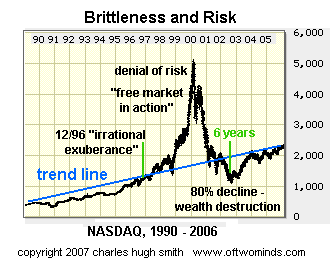 Another way to think about brittleness and resiliency is to look at risk. A classic
example is forest fires. In the normal cycle of events, dry underbrush and other material
accumulates on the forest floor, becoming the fuel for a fire which burns the dried leaves and branches,
fertilizing the soil with the ashes and setting the stage for regrowth.
Another way to think about brittleness and resiliency is to look at risk. A classic
example is forest fires. In the normal cycle of events, dry underbrush and other material
accumulates on the forest floor, becoming the fuel for a fire which burns the dried leaves and branches,
fertilizing the soil with the ashes and setting the stage for regrowth.
Every so often, various conditions lead to a period without smaller fires, building up enough fuel for a large conflagration. These larger events tend to obey what's known as a power law: the more infrequent they are, the larger they are (and vice versa). Here is an explanation by Jim Sloman: In fact, they found that the size of earthquakes followed a law known to mathematicians as a power law. This law, now known as the Gutenberg-Richter Law, states that when you double the energy of an earthquake it happens four times less frequently.So what happens when authorities stamp out all small forest fires? They create the perfect conditions for a gigantic conflagration. The flaw is the old forest management policy of suppressing all forest fires was revealed when a huge uncontrollable fire swept through Yellowstone National Park some years ago. In other words: a system which allows occasional fires is resilient, while one which suppresses all small fires guarantees a giant conflagration. In financial terms, this "normal cycle" of growth, small fires and regrowth is "the business cycle" in which credit and business expand, eventually reaching an unsustainable level (high inventories, too much debt and capacity, etc.) Businesses go bankrupt, defaulting on credit, people save rather than borrow, and capital is accumulated for the next cycle of investment and borrowing. 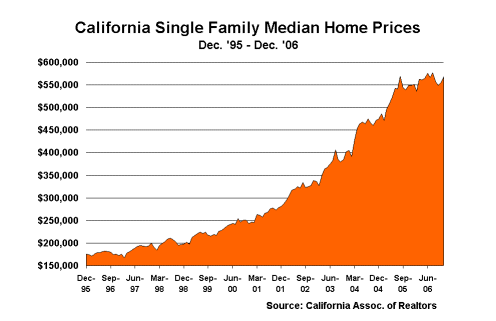 Consider the above chart of the Nasdaq dot-com era bubble. Fed Chairman Greenspan
famously warned that there seemed to be an awful lot of dry underbrush accumulating
in the stock market back in 1996, but the nervous swoon which greeted his observation
soon passed, and the glorious euphoria of "free market forces at work" resumed, leading to
a peak of over 5,000 in March 2000.
Consider the above chart of the Nasdaq dot-com era bubble. Fed Chairman Greenspan
famously warned that there seemed to be an awful lot of dry underbrush accumulating
in the stock market back in 1996, but the nervous swoon which greeted his observation
soon passed, and the glorious euphoria of "free market forces at work" resumed, leading to
a peak of over 5,000 in March 2000.
How many analysts and pundits recognized the tremendous risk at the height of the bubble? Very few. Various Cassandras had been warning of rising risk for years, but their paltry investment returns only seemed to prove they didn't know what they were talking about. But like a rubber band being stretched ever farther--or a forest accumulating dry brush for years on end--an "event" was inevitable. Here we have a chart of housing prices in California. Hmm. Anyone else see an accumulation of dry tinder awaiting a lightning strike? There is another analogy for this notion of risk: a grain ship over-run with rats. Let's say there are virtually no controls on the population of the rats, and as a result they proliferate at an astonishing rate, engorging themselves on the seemingly limitless supply of grain. Alas, as the population explodes, the competition for the remaining grain increases. As the winners consume the last of the grain, the entire ship's population is doomed to starvation. A once-stable population explodes beyond its means, and then collapses. Hmm. Now let's substitute hedge funds for the rats, liquidity for grain, and competition for "alpha" (gains in excess of the broad market). Scroll back down to Monday's entry and take a look at the rise in derivatives. Does it remind you of Nasdaq's final rise? Perhaps it should. And what happened to Nasdaq in the 2.5 years following the peak? Collapse. Just to extend the analogy: there are only about 10,000 tradable stocks in the investment universe, and it's estimated there are 9,000+ hedge funds--the exact number is unknown due to lax oversight. One hedge fund for every public company. Does anyone else think the rats are approaching the last bags of grain? January 30, 2007 Vulnerability, or, Thinking About the Unthinkable The President of Iran has made no secret of his desire to destroy Israel, a small nation which zealots gloatingly describe as a "one-bomb state," meaning that one nuclear bomb would wipe the country from the map. But perhaps the Iranian zealots should take a close look at a map of their own nation before they gloat too much. For one glance reveals that theirs is about a "ten-bomb state" facing an opponent (Israel) with an estimated 25 to 50 nuclear-armed missiles. 
As we discussed yesterday, systems in which key components or assets are highly concentrated are inherently brittle, or vulnerable. As we peer into the dark globe that is nuclear war, we should recall that many people thought very deeply about the issues of vulnerability, targeting and survivability during the Cold War between the U.S. and the U.S.S.R. For starters, I would recommend a classic of that literature, Thinking about the Unthinkable Though it is widely assumed a nuclear war means the end of a nation, even one as large as the U.S., it is not strictly true. The level of destruction depends of course on the number of weapons deployed, but it is heavily dependent on the diffusion /concentration of a nation's assets. A comparison of the U.S. and U.S.S.R.'s brittleness and resiliency--a comparison of the concentration and therefore vulnerability of key assets--reveals that the Soviet Union was far more vulnerable to a nuclear attack than the U.S. for the simple reason that the majority of its human and physical capital are centered in Moscow. With few ports and rail centers, and much of its energy and military complex in tight concentrations, a "limited strike" of perhaps 100 weapons would have destroyed virtually the entire core of Soviet power while leaving most of its people unaffected. The political, transportation, energy, military and human capital of the U.S. is more widely distributed, and so even though a 100-weapon strike would have devastating consequences, to say that the U.S. would be utterly destroyed would simply not be true. There would be roads, railways, ports, energy assets, intellectual capital, and political structures which would survive a 100-bomb strike. Now I want to stress here that I am not underplaying the effects of nuclear weapons, or advocating their use. I am simply pointing out that states in which the capital city contains the vast majority of the nation's political and intellectual capital, as well as much of the industry, expertise, transportation and energy facilities, are far more vulnerable to nuclear attack than nations with widely dispersed assets. Even a cursory look at Iran reveals that the majority of that nation's human and physical capital is in Tehran, and much of the nation's primary asset--oil--is concentrated in a handful of fields and transported in a handful of pipelines. Most of the country is a desert wasteland; once its capital were leveled and its oil facilities destroyed with ground-burst nuclear weapons, there would be few resources or assets left to work with. My point is simply that a "ten-bomb state" with highly concentrated assets had better be careful toying with a "one-bomb state" with 25-50 deliverable warheads. The Israels would, after the first 20 or so weapons, be reduced to hitting secondary targets or "bouncing the rubble" in Tehran. There are also various levels of brittleness and vulnerability in weapons delivery systems. If your missiles are above ground or in visible (and therefore targetable) hardened silos, and you have a habit of boasting about your desire to deliver a nuke on said missiles, your enemy may decide to pre-emptively destroy your missiles with an air-burst nuclear weapon, frying its electronics, guidance and command-and-control systems, or destroying the silos with ground-burst nukes. The Israelis are also proported to maintain an undersea-launched (i.e. from a submarine) missile capability, one which is very hard to pre-emptively destroy. Which has the more resilient system? The "one-bomb state" with submarine-launched nuclear tipped missiles, or the "ten-bomb state" with vulnerable surface missiles? Just for comparison's sake: The U.S. maintains 18 "boomers" (Ohio-Class Fleet Ballistic Missile Submarines--SSBNs), each armed with 24 D-5 Trident missiles, which are each armed with 5 independently targetable warheads (MIRVs). Each U.S. SSBN thus carries 120 nuclear warheads, launched within one minute and deliverable anywhere in the world. That's 2,160 nuclear warheads distributed among 18 very-hard-to-locate boats. Not all are at sea at any one time, but catching a few in dock would still leave 1,500 or so nuclear weapons available for a counter-stike. What nation would chance absorbing even one SSBN's load of 120 nuclear bombs? That is resilence, which in the parlance of nuclear war translates to deterrence. It's a word which should be in everyone's vocabulary--even those ruling a "ten-bomb state." (Note: to comply with the Start II nuclear weapons reductions agreement with Russia, the U.S. will reduce its fleet of Ohio-class submarines from 18 to 14 in a few years.) But nuclear deterrence is not robust in all circumstances. As we have learned, it has little value against stateless terrorism--or even the state-sponsored variety. Just as a thought experiment: what if an anonymous nuclear bomb were to be trucked into the heart of Tehran and detonated? Yes, there are "signatures" to weapons--how "cleanly" they exploded--but what if a "clean" weapon were modified to be "dirty" enough to look amateurish? Then who would the President of Iran--were he still among the living--attack? The deterrence of nuclear bombs doesn't erase the threat of nuclear terrorism, it would seem, even for those states which sponsor conventional terrorism. January 29, 2007 Brittleness Some time ago our U.K. Correspondent sent in some comments on the "brittleness" and resilience of systems--such as economies. This is a "systems analysis" view of complex systems, and as such it can be profitably applied to everything from the immune system to the electrical grid to the stock market. Here is his brief commentary: (emphasis added) Moving the analogy to economics I would ask: Is it better to have an economy that degrades and rebounds gracefully under stress or one that bears heavy loads but which fails dramatically when it hits the limits? The first is inherently robust but exhibits many variations in state. The second shows much more stability - but offers fewer indicators of the stresses the system is under. 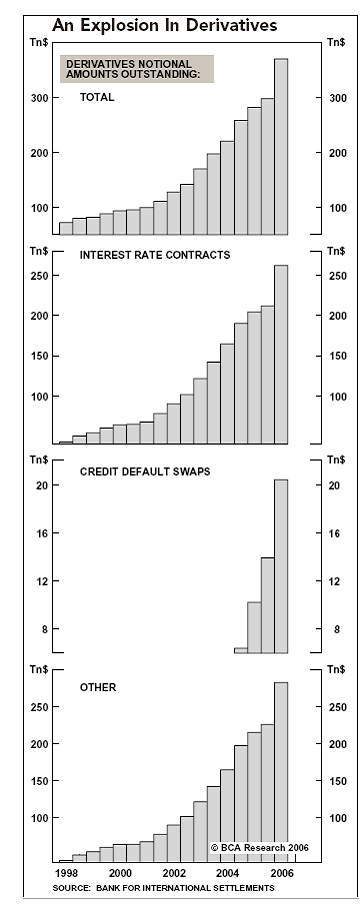 Though I am still learning about such analytic tools, it seems that many of the complex
systems we rely on are also extremely brittle in the sense that they depend on a handful
of chokepoints.
Though I am still learning about such analytic tools, it seems that many of the complex
systems we rely on are also extremely brittle in the sense that they depend on a handful
of chokepoints.
And so on. The idea behind hubs and ports and highly consolidated industries (there are only two manufacturers of large commercial aircraft in the entire world, for instance) is that the resulting economy of scale will be efficient. But as our U.K. Correspondent points out, that consolidation carries a cost which is only visible when the brittleness of such concentration becomes glaringly apparent. To take another disturbing example: bird flu (H5N1) has killed 150 million birds globally. This virus somehow overcomes birds' normally robust immune system. Research suggests that the global Flu Pandemic of 1918 which killed millions of humans was a bird virus which "jumped" to human hosts. The immune response to that virus caused massive congestion in the lungs, causing the human host to suffocate. In effect, the normally resilent human immune system was rendered brittle by this terrible microbe. The global financial markets, we are constantly reassured, are actually made more resilient by the instantaneous flow of capital across borders and by the proliferation of derivatives. But what if the opposite is true, and the global financial markets have been pushed by an unprecedented tide of derivatives to the edge of chaos? More on that later. January 27, 2007 Portrait of the Artist II Thank you to everyone who responded to yesterday's entry and/or wished me well with my new novel: Bill M., Michael G., Albert T., Kevin M., our U.K. Correspondent, et. al. I think Kevin put into words what many of us feel: While reading your blog today, I was struck by a way of thinking and living that I have subscribed to (or tried to anyway). I am tired of being a "consumer / producer," and as such I no longer worry about anything creative that I do as having any commercial value. I simply enjoying creating things. I too play my guitar 30 minutes to an hour a day. I enjoy working on my motorcycle. Even mowing my yard. The end result and the process itself is my reward, and I don't worry too much about what other people think.There's a lot of wisdom in those words.... Several readers requested Richard Russell's views on Chelation therapy, and correspondent James C. was kind enough to send me a copy. It is currently in Microsoft Works format, which should open in most Windows PCs. If you have a Mac, try downloading the file and then opening it in a Mac word processor. I will transfer it to HTML when I have time: Russell on EDTA Chelation. I should note here that I am not recommending this or any other treatment. What I am recommending is doing your own research, and maintaining both an open mind and a skeptical mind. No one treatment or lifestyle works for everyone; learn as much as you can, and take charge of your own health. Here are some interesting links for weekend browsing. Polymath reader Bill M.'s own website is a delightful mix of eclectica (is that a real word?), including a large-batch recipe for thin pizza crust dough and some stunning craftwork: amulets and chimes. Frequent contributor U. Doran sent in some links to stories you may have missed. Everyone talks about hedge funds, but how much research about this shadowy industry have you read? Here's a Deloitte Reserach Group report: Risk Management and Valuation Practices in the Global Hedge Fund Industry. Doran also sent in a report on the dollar and bonds (lots of good charts) and another important one which explains how the "new" CRB (Commodities Research Bureau) index has changed dramatically from the "old" CRB index.  Lastly, several readers have been asking for recent entries and noting that they're not in
my archives. That's because I've fallen way behind and need to devote some time to updating
the archives. I am also starting a new archive for 2007 which will include the date of
each entry. Given the hundreds of stories and entries cluttering up this site, I need to
start a new archive lest the existing one become too cumbersome to use.
Lastly, several readers have been asking for recent entries and noting that they're not in
my archives. That's because I've fallen way behind and need to devote some time to updating
the archives. I am also starting a new archive for 2007 which will include the date of
each entry. Given the hundreds of stories and entries cluttering up this site, I need to
start a new archive lest the existing one become too cumbersome to use.
As for the photo: what could be more all-American than a rock-n-roll jam with the flag and a classic Fender Stratocaster? OK, I should be playing slide with an empty bottle of American beer rather than a Beck's, and I am sure there were some Sierra Nevada bottles awaiting the next break. If you haven't heard my songwriter buddy Mike Dakota's tune King George is Back, check it out (it's an MP3 file). That's me on first lead guitar (not very good but it at least it doesn't ruin the song). Another excuse to thank you readers: at some point this week, the 500,000th visitor since 1/1/06 will view this site (and hopefully won't leave in a huff). January 26, 2007 Portrait of the Artist as... Scullery Maid  While I was scrubbing the bathroom floor yesterday, my mind wandered to the film
American Splendor
While I was scrubbing the bathroom floor yesterday, my mind wandered to the film
American SplendorIt's the story of what you might charitably describe as an eccentric (or misanthrope, if you prefer) who is driven to create comic book dialogs. Since he can't draw worth beans, he illustrates his stories with childish stick figures. But by happenstance he knows comic book artist (and fellow eccentric) R. Crumb, who likes the stories and goes on to illustrate many of them. ("Six Degrees" note: my brother's office in the south of France is located a stone's throw from R. Crumb's home in a small, terribly picturesque old village.) Gary's point about artists (meaning any creator, not just a painter-type) is that the real ones have to create what they create--it is not willed or even stoppable. The character in American Splendor is just such a person--he doesn't calculate the probable success of his art/creations, or model them on others' templates--he just does what comes to him. He literally cannot stop himself from putting his ideas to paper. We know this Portrait of the Artist as Slightly Mad Godlike Creator from various movies, and of course the guy/gal is always eventually recognized as a genius. But there are many more creative types (like me, for instance) who never achieve any recognition. Hence, Portrait of the Artist as Scullery Maid. Maybe our work is mediocre, or not of our own era, or maybe it's just too bizarre to ever resonate with enough people to achieve recognition/popularity. The artist has no idea why he/she is scrubbing floors rather than being toasted by the glittering critical elite. This is not a complaint, just a reality. You may wonder why I tossed in a photo of myself playing my 1976 Les Paul Deluxe. I did this mostly because I was tired of text-only entries, and wanted some color, but the other reason is to illustrate the point: I am a mediocre musician, but I have fun improvising and learning (slowly) new material. When I'm feeling good, I often play for a half-hour or more a day (usually acoustic, to keep my fingers strong). When I'm down, I don't play. Creating something, even a melody no one else will hear, is its own reward. Ditto a nice meal, a sketch, a poem, or any other creation. The glory of art is a false attractor. As a writer, I have struggled with this question: am I really driven to put down this story running in my head, or am I merely hoping to win recognition? After two decades of very limited success, it's clear that I am doing it for the internal rewards of creation. The external rewards have been limited and are very likely to remain so. (My first novel was a commercial bomb, selling only a couple hundred copies last year. This is, my publisher reports, pretty typical--but still, disheartening to the hopeful artist.) As for free-lancing--the average free-lance writer makes less than $5,000 a year. Hoo-hah. The illusory nature of artistic success is brilliantly illustrated by the 1960 film The World of Apu, I just finished a 160,000 word novel and shipped it to my publisher. Only God knows if they will like it and publish it, or if it will languish for the rest of my life on a dusty shelf, waiting patiently to be tossed in the recycling bin when I croak off. Either scenario is possible, with the odds favoring the latter. This is the deal with creating: you can't know there will be a market for your ideas or work. The odds are there won't be. the only thing the artist can know is: that melody sounds good, this sentence sounds right, that stroke of color works. Important correction: Yesterday's entry stated that government employees have no stake in Social Security. As knowledgeable reader Nikki reports, that is no longer true: This is only true for federal employees under the Civil Service Retirement System (CSRS). That ended in 1998, and all Fed employees hired since then, like me, do indeed have to pay into SS under FERS, or the Federal Employee Retirement System. I've got SS taxes taken out of every check, and I'm convinced I'll never see a dime. But be assured that some fed workers do worry about social security.Thank you, Nikki, for this clarification. January 25, 2007 Readers Weigh In Taxes, entitlements and military spending have generated a wide variety of interesting commentary. Herewith is a selection (slightly edited for length) of reader feedback. Strawgold makes an excellent point about government employees' retirement plans and Social Security: I read your column about Social Security and “who gets hurt” if it goes under. But here’s what makes even more interesting reading: GOVERNMENT WORKERS DON’T HAVE TO WORRY ABOUT Social Security GOING UNDER. They are not covered under it like the rest of us ( yes, us - the ones who are paying for everything) are. THEIR retirement plan, through the good old Federal Govt has our meager Social Security beat all to the devil and is in no danger of being phased out, or going broke in the same way.Those familiar with the philosopher John Rawls will find resonance in David M.'s observations on morality and taxation: I again have had to suppress my disbelief at the world when reading your reader’s comments in your latest blog posting. His assertions that he has a “right” to all his earnings have at least two main problems: he has undoubtedly benefited from a peaceful society, education, and transportation; and society as a whole is likely to suffer from his expenditures (pollution, scarcity of resources).Frequent contributor Michael Goodfellow comments on the correlation between low tax-rate nations and high GDP, and on my DoD spending entry: I also wondered what would happen if you listed those same countries in your international comparison sorted by GDP per person. I'm pretty sure the U.S. and Japan would be number 1 and 2, just as they are last in taxes on your graph. Not sure the correlation would hold up, but it still should make you think.Another astute reader (Michael) was kind enough to send in a link on Affluenza and the consequences of our cultural obsession with material wealth: Earn more, spend more, want moreNext up is David A., who comments on the unsustainability of the Social Security model, and on governmental waste: Charles, all this vastly huge Medicaid/Medicare and social security spending is in the future so THAT DEBT DOESNT COUNT!!! future debt isn't important as we will be able to pay for it in some miraculous, painless way!Frequent contributor Harun I. notes that morality isn't the only metric for taxation, nor is the cost of maintaining a military the only consideration--losing is expensive, too: I didn’t take your view about taxation from a moral standpoint but from a correlative perspective. I also take issue with some of your readers linear thinking in regards to complex non-linear social issues. There may not be a moral basis for taxes to support social welfare but what will we do when the poor and disaffected are rising up in revolt. I have no answers, I merely raise the question of whether morality is the only benchmark by which social policy is formed. The poorest members of any society will burden that society to some extent and possibly in ways that are very undesirable.Correspondent Mark D. shares some history on the weapons development process, and comments on "over-teching": I really enjoyed your comments on the defense industry. Both my parents worked for Lockheed, as well as several family friends during the days of the Tristar days, as well as the older, I forget the name of the passenger plane with the funny tail. they always complained about management sticking with Rolls Royce, and that, at the time, the strength of Lockheed was efficiency of design, efficiency of aircraft, though not in vogue at the time, turned out to be inconsequential, then, but not now. My Dad worked on the Aquila, something that actually got cancelled! I had a neighbor that worked for Ampex and helped minaturize the VCR for flight recording for bombers and was PISSED they sold it to the Japanese. now he makes 1/8 scale WWII RC fighters with EVERYTHING to scale including flaps, twisting landing gear etc.Since I'd discussed the relative merits of Boeing vs. Lockheed on the C-5a aircraft, I asked Mark for the views of the Lockheed retirees he knows. His answer sheds considerable light on another source of "waste": the over-spec'ing of every component: To a man, er woman, they all said Boeing would have done a good job, too. Most said cost overruns are underestimated based on waiting for security clearance while doing nothing, (average of 6 mos?), requirements on procurements, such as complying with the wood source of hammers, making sure the hammer can hammer (labor, etc). Based on some of this, wood source is known, but i don't think anyone would buy a hammer made out of teak or mahogony, but someone still has to run around wasting time making sure the hammer was purchased conforming to requirements. That list is not infinite, but not measurable.Kevin K. has some doubts that reforming Medicare to emphasize prevention would work: I was talking about your BLOG with a co-worker and even though it is sad to say, we both agree that most spending on "prevention" will do nothing.Kevin also recommended the recent film on the dumbing-down of America: Idiocracy James C. raises the issue of what therapies are being ignored in favor of profitable pharmaceuticals and surgery: Health care is the one topic that I get more up in arms about than economics and investments. Have you read Politics in Healing by Daniel Haley? Do you know about IV Chelation Therapy? The medical establishment in America has become one of the most shameful aspects of our society. Worthwhile treatments and preventative methods are cast aside because they do not generate enought profit. I know about Chelation because I have studied the subject for close to four years and have been using the treatment for over a year. It works and is, in my opinion and the opinion of many other patients that I have met at the clinic, a much more effective treatment than bypass surgery, drugs et. al.And this just in, from frequent contributor Aaron K., on Medicare waste: I'd like to add to the mix that base health care costs are anomalously high even without poor medical spending decisions, due to the employer-based tax structure of the system. I wrote an extensive essay on the matter here, titled as above:What an extraordinary range of commentary! Thank you readers, for your contributions and thoughtful contributions. January 24, 2007 Medicare Waste--50%? Correspondent Paul M. raised the issue of waste in Medicare vs. waste in the Department of Defense. It's an important question, but rather than focus only on the waste which can be measured (over-billing, paperwork, fraudulent charges, etc.) I'm going to to take a "big picture" view and ask: how much of that $400 billion actually alleviates suffering, heals/cures the sick, and improves the health of elderly Americans? Could we do better for much less money? The corollary question is: how much healthier would Americans be (of all ages) if we spent some of that $400 billion in other ways, say on prevention rather than after a person is already ill or disease-ridden? Medicare program costs have risen from $70 billion in 1985 to $162 billion in 1994 to $390 billion in 2007 and are estimated to rise to $500 billion in 2011. Adjusted for inflation, that $70 billion 20 years ago should only be $130 billion now, not $390 billion. Are we three times healthier than in 1985? There's a variety of metrics we could use, but we shouldn't rely too heavily on longevity, in my view; "quality of life" (though harder to measure) is what counts to the patient and his/her family. This is a long entry, but this is a program which will, in its current runaway form, bankrupt our nation. (thanks to correspondent John B. for this link): Bernanke Warns of Looming Deficit Crisis (MSNBC 1/18/07) Let's start with the fraud and waste which can be measured: over-billing, etc. This has been documented for years: Waste in Medicare, 1995 Here's a Washington Post series from 2005: Bad Practices Net Hospitals More Money; High Quality Often Loses Out In the 40-Year-Old Program Accreditors Blamed for Overlooking Problems Once Health Regulators, Now Partners All of this is IBD--Important But Dull. Let's face it--an astounding number of folks profit immensely from billing Medicare. It's the golden trough not just for large companies but small ones, too. My thesis here is more radical than just "Medicare is riddled with waste, fraud and poor practices." I think a strong case can be made that 50% of Medicare funds are wasted in the sense they do not improve the quality of patients' life but often degrade it further: patients are needlessly placed in harm's way by encouraging risky, useless or harmful procedures in hospitals teeming with incurable staph and other infectious agents, patients are loaded up up with a dozen or more drugs which have never been tested in such an interactive stew of other pharmaceuticals, regardless of the relatively low value of the drugs as curative agents, or even outright negative affects of such drugs and perhaps worst of all, funds which could have made a difference in preventative care earlier in the patients' lives are squandered on the patients' last few weeks or months, after they've contracted lifestyle diseases such as diabetes, lung cancer, liver diseases and heart disease. Lest you think I exaggerate, here is Page One of yesterday's Wall Street Journal on the growing evidence that stents--one of the most common operations for heart-disease patients-- are not helpful but actually detrimental: (subscription required, or go to your library and read the print edition for free): The Case Against Stents: New Studies Hint at Overuse There is an alternative to useless, expensive (and immensely profitable) surgical procedures like inserting stents, which is called the The Heart Healthy Lifestyle Program by Dean Ornish, MD. What's the problem with the Ornish Plan, which has been clinically proven to reduce heart disease? You can't make any money off it! How the heck can I make billions off useless stents, useless drugs and dangerous operations with lifestyle changes which are controlled by--gasp--the patient? Well, you can't, and that's why Medicare is a largely worthless waste of $390 billion (soon to be $500 billion): it pays for operations, drugs, devices and "care" which rarely cure diseases or benefit the patients' quality of life. It does, however, create a vast trough of money which fattens companies and "healthcare" businesses with billions in profit. Do you think I exaggerate? Take statins, drugs which are routinely prescribed to millions of Americans with high cholesterol. Well now it turns out--surprise!--these drugs have side effects which are long-term bad news, and even worse, lowering cholesterol doesn't seem to be the risk factor that the Medical Powers That Be assumed. Here is the Center for Medical Consumers: CHOLESTEROL SKEPTICS AND THE BAD NEWS ABOUT STATIN DRUGS These cholesterol trials also looked at total mortality, that is, the deaths from all causes, and found little difference between the study participants who tried to lower their cholesterol and those who did not. In other words, some clinical trials showed that the heart disease death rates were, in fact, lower among men who had reduced their cholesterol levels. But this benefit was offset by a higher rate of deaths from other causes.And what happens if you question this stupendously profitable status quo? Your research funding gets cut off: Bad News About Statin Drugs "Anyone who questions cholesterol usually finds his funding cut off," said Paul Rosch, MD, who started his talk with a reminder that half of all heart attacks occur in people with normal cholesterol levels. "Stress has more deleterious effects on the heart than cholesterol," said Dr. Rosch,In other words, statins may actually increase the risks of heart attack rather than lower them. So why doesn't the FDA announce that statins are dangerous and not helpful? Because the pharmaceutical industry would freak out that their billion-dollar gravy train would end. Take a look at this story for more: (thanks to correspondent U. Doran for this link) Cholesterol, Lipitor, and Big Government Meanwhile, thanks again to U. Doran, we have this New York Times story reporting that plain old vitamin B, Niacin, is effective in lowering cholesterol and safer than the statins: An Old Cholesterol Remedy Is New Again If you believe that statins and stents are rarities, then you need to check all the meds your elders are taking and delve deeply into their safety and efficacy trials. You will find most meds help only a subpopulation of potential patients, and the side-effects can be serious. Say a drug seems to do some good in 20% of the trial patients, and doesn't seem to do too much harm to the other 80%--it will be approved. But what if side-effects take longer than the trial length to appear? What if the drug is overprescribed because "we have to do something to help the patient"? What if it interacts negatively with other medications? None of this comes out until the damage is already done. And if you're skeptical that lifestyle changes actually work, (stop eating junk food, start eating real food, pursue modest regular exercise--you know the drill) then read this U.K. study in which people ate a "primitive" human diet: eating a primitive diet lowers weight, cholesterol, blood pressure. The participants' health magically improved in just a few weeks: lower weight, more energy, lower cholesterol, lower blood pressure--what's not to like? If there was a drug which did all this without side-effects, it would sell in the tens of billions. But there is no such drug, nor will there ever be such a drug. "Health" is not a single metric but a systemic condition of healthy food intake, healthy mind (i.e. not depressed or stressed out) and a lifestyle which includes regular exercise. There's nothing mysterious about the process of healing and getting healthy. But it does take jettisoning the entire American diet of French fries, high-fat, high-salt high-fructose packaged food. My own observation is that American packaged food (canned goods, frozen meals, etc.) are much saltier and sweeter than they used to be a few decades ago. On the rare occasion I eat a canned soup (a can someone gave us, since I never buy any packaged food), I am astonished at the high fat content, the high salt and/or the high sugar content. Read this for more: (thanks to correspondent U. Doran for this link) Does High-Fructose Corn Syrup Have to Be in Everything? We all know fast food is basically garbage--high fat, no anti-oxidants, low fiber, high-fat salad dressings for the "healthy salad" made with junk oils, etc. etc.--but basically the rest of the American diet--all packaged food, baked goods, soda, etc. etc.--is also not healthy. If you travel abroad a bit, you discover that other cultures still eat "real food"--actual vegetables and grains and meat which is purchased and prepared at either home or a restaurant. Yes, American fast food has made enroads elsewhere, and thus nations which had few obese young people are now seeing a rising number of unhealthy fat kids. Recall that "lifestyle" diseases like diabetes have shot up from near-zero a few decades ago to epidemic levels. Pima Indians who live in the U.S. have horrendous rates of diabetes, while their next-of-kin (same genes) across the border in Mexico have none. What else do you need to know about the causes of diabetes? Here's more on research on the Pima tribe: Obesity and Diabetes My own observation is that exercise is more important than generally credited. People in northern Europe eat a lot of meat, white bread and cheeses--food which by "health nut" standards should have put them in an early grave-- and yet their lifestyle of eating modest portions and walking (i.e. "French women don't get fat") make them just about as healthy (in terms of longevity and quality of life) as the Japanese and Okinawans who eat a diet low in red meat and dairy products. Various cancers have been linked to high-fat, high-protein diets, as has arthritis. I don't have the time to list all the links--do your own research. It's all there at your fingertips. Then there's my own personal experience of the elderly people I have known. My uncle seemed a bit frail, but stable, but he went in for some operation which was supposed to fix something. He died in the hospital. Our old friend Joe was told he had an aneurysm in his chest, and the doctors decided to "fix" it. He died in the hospital. I could go on, but you have your own stories, no doubt. I can honestly say that I do not know one elderly person who entered the U.S. Medicare/"healthcare" system with a health issue (or a supposed health issue) other than an infectious disease which could be knocked down with antibiotics or a parts replacement (inter-ocular lens, hip, etc.) and emerged "healed," "cured," or alive and well. Is this just bad luck on my part, or the reality nobody wants to talk about? Meanwhile, their last operation and intensive-care stay cost the taxpayers hundreds of thousands of dollars, and enriched the doctors, hospital, etc. Did the doctors feel they "had to do something" lest they be sued later? Very likely. Did the doctors feel they "had to do something" because their training stressed that over "first, do no harm"? Very likely. Did the soon-to-be dead patient willingly go in like a lamb because he trusted the doctors to make the right decision for him? Undoubtedly. Instead of this insane system which waits until you have a life-threatening disease and then treats it with operations that don't work and drugs which actually do more harm than good, what if Medicare was operated for the health of the citizenry rather than for the profit of the "healthcare" industry? Let's say $100 billion of the $400 billion was set aside for prevention. What if every American who turned 45 had to go in for a physical to qualify for future Medicare, and if they smoked, were obese, drank too much/were a druggie, had incipient heart disease from lack of exercise, etc., then they would be told, "We are partners in your health. We cannot fix illnesses like diabetes, alcoholism, lung cancer and heart disease later--we have to fix them now, and you have to do your part. And if you don't take any responsibility for your own health, well, the care choices under Medicare are limited. Frankly, the government isn't here to save you from your own unhealthy lifestyle." A followup exam and lifestyle assessment would be required at 50, 55 and 60, making sure the future Medicare recipient was doing all that he/she could to maintain their own health. And if they continued to smoke and carry 50 extra pounds of weight, they would be warned that Medicare didn't cover "lifestyle-induced" illnesses like lung cancer and heart disease. In other words, if you're not partnering up and doing your part, the government isn't going to save you. Instead of sugar-coating reality (is that all that Americans can stand now, sugar-coated reality?), they would be told:"What you ruined--your health--cannot be repaired with any amount of money, and so we're not going to support the illusion that there's a miracle cure or surgery. We will keep you comfortable." When did personal responsibility stop being part of healthcare? If you drink like a fish and get a DUI, your insurance skyrockets. If you continue to abuse alcohol and get another DUI, you're in big trouble. (In much of Europe, it's one strike and you're out: one DUI and you lose your license.) If you persist in destructive personal habits like drinking and driving, and you get nailed with a third DUI, you're out: your license is pulled and insurance--forget it. My family has a history of alcoholism, so I'm not being cavalier here. Alcoholism is a serious condition which is very tough to manage. My siblings and I are able to drink responsibly, but I have friends from similar families who are teetotalers. Whatever works--the main thing is to take responsibility for your own health and risk factors. Yet if you smoke, drink heavily, eat poorly, allow yourself to become obese and don't bother exercising, then there's no cost? The government is supposed to somehow "cure" you despite your abuse of your body and your forfeiture of any personal responsibility? Why? Why are you responsible for some things but not for your own health? This lack of patient responsibility is built into the system. The system is set up to "process" lumps of passive clay: cut 'em open, give 'em meds, send 'em home. Here's just one example. My 80-year old father has osteoporosis. For this he has been given various puffers and pills to take. But no one in Medicare, or the entire vast system it feeds, has ever demanded that he do anything himself to improve his condition, though what this is--simple exercise--is well known: Bone density sharply enhanced by weight training, even in the elderly. There is another fatal flaw in Medicare, and the entire U.S. "healthcare" industry: if you want to drive in a thumbtack, all you get is a sledgehammer. A close family friend was an internal medicine MD for decades in a busy urban hospital. He once told me that there was nothing wrong with half the people who came in to see him; they just wanted to talk. My own grandmother combatted loneliness and boredom with weekly visits to the doctor for vague ailments such as knee pain (Tylenol) and feeling low (anti-depressants, which never worked--why? Because she wasn't depressed). The doctor was pleased to bill Medicare for a 5-minute visit. If you think this isn't common, you need to spend more time with elderly people. An elderly friend we keep an eye on (she has no surviving family) goes to Kaiser Hospital on a constant basis for basically the same reason: it gives her something to do. She recently insisted on an operation on her hand, and surprise, surprise: now her hand hurts more, and only closes halfway. My father fell and fractured a bone last year, and so he spent a week in a rehab clinic. The gentleman with whom he shared the room had no real reason to be there; since we were with my Dad every day, we started talking to this gent. Turns out his daughter worked all day, and so he was lonely. Every few months he'd conjure up a reason to go into this rehab clinic (at hundreds of dollars a day) just for some human companionship and stimulation. So what we have is lonely seniors, and what we offer is horrendously expensive medical "care" for their relief: a sledgehammer for a thumbtack. What depressed seniors need is a ride to the senior center, to join a depression management group, etc. This would be so much cheaper--and kinder, and more effective--than giving them a basically free visit with a doctor who then feels obligated to "do something" which ends up being costly, useless or even detrimental. Personal responsibility seems to be a lost value in American life now. Hey, we all want to eat a quart of ice cream and gobble down chips and fries--they taste good, and in fact are engineered to taste good. (Have you ever noticed that the labeling on animal feed is more detailed than the information provided on human food?) But there's a cost to eating junk, so we can't indulge in irresponsible eating any more than we can indulge in irresponsible drinking. I like ice cream as much as the next sweet-tooth, but I eat it a couple times a year, at birthday parties. Do I miss it? Occasionally. Ditto the other things I no longer eat except on rare occasions--doughnuts, chips, fast-food burgers, etc. But is our life ruined by foregoing all this stuff? I think it's abundantly clear that it's ruined if we eat it as often as our taste buds (and emotional situations) desire. What's sad (or ironic, if you're cynical) is that once you get overweight and contract diabetes--and yes, I do have friends with diabetes--then you can't eat that stuff anyway, but now you have to monitor your blood sugar and worry about losing years off your life. Yes, many diseases are genetic and "not my fault;" I'm fair-skinned so I am at risk of skin cancer, even though I wear sunscreen and a hat every day. African-American men are at higher risk of prostate cancer, and so on. The lens in our eyes cloud up with age, and have to be replaced with a plastic lens. Fine; that's not too costly. Hips and knees give out earlier in some of us than others (not always from carrying around an extra 50 pounds, but that certainly doesn't help.) Fine. It's straightforward to diagnose, the cost is standardized and the pay-off is immense. We all have medical conditions which may rise up into crisis even if we have led a healthy lifestyle. Yes, Medicare should pay for the treatment of these diseases and body-part replacements. But how much of the $400 billion is actually spent on this type of care, and how much of it is actually effective? How much is worthless MRI tests so the clinic won't be sued later for "not doing everything possible"? So here we are: as a nation, we spend 16% of our $13 trillion GDP on "healthcare," and will very shortly be paying more for Medicare than the entire Military and V.A., yet it is clear we are an unhealthy nation: poor child mortality rates, high obesity rates (either 40% or 60% of the adult population is overweight, depending on your metric) and so on. There have been public health victories: smoking has receded, greatly improving the lives and longevity of those who quit and those who live with them. Some genetically caused cancers, such as aggressive breast cancer, have improved drug treatments. Yes, some pharmaceutical research does result in drugs which improve the patient's life--but not as many as you might think. A close friend's wife just went through surgery for colon cancer. My friend is a physicist by training so he did voluminous, painstaking research on the pros and cons of chemotherapy. He concluded that the difference in the 5-year and 10-year survival rates for those who endured chemo and those who did not were statistically insignificant. In other words, a horrendously difficult and expensive treatment which is recommended without hesitation by the "establishment" has very little chance of prolonging the patient's life, though it puts the patient through six months of Hell. This is not some outlier; this is common. The conclusion: we pay trillions for medical care which doesn't work or actually makes us sicker, more at risk of illness or just flat-out kills us. Medicare is an insane system in which the government does virtually nothing to educate (or cajole) people into improving their life through preventative lifestyle improvements, but waits until the person is old and ill, and then it expends hundreds of thousands of dollars on the person's last days, wasting the money on illusory "solutions" and robbing the patient of their dignity and the opportunity to die in hospice or at home. If we set out to design a more wasteful, destructive, useless system, I don't think we could do better than the current Medicare system. My own personal experience suggests that we'd actually be better off if Medicare simply went away and was replaced with a preventative-care system which sought to identify risks in middle age (or even sooner) and enrolled the patient in a partnership of health. Thank you, Paul, for raising the issue of waste in the Department of Defense and Medicare. I hope I have found some links which have added to readers' knowledge. January 23, 2007 A Closer Look at Department of Defense (DoD) Spending Correspondent Paul M. challenged me to back my (wild, unsubstantiated) assertion that the DoD budget contains less waste than Medicare. This is important, so please follow along with an open mind. There are plenty of links for further reading. Today I offer a glimpse into Pentagon spending. Please note that the Pentagon is a civilian agency. The U.S. Armed Forces do not budget the money or assign the contracts: this is done by civilians under the control of the President and Congress. Please keep this separation in mind. My stepfather was career Air Force, and I learned this distinction is key in any analysis of spending and "waste." (One person's waste is another person's job--and don't forget who controls spending: politicians, not Generals and Admirals.) As for Pentagon waste: I am skeptical of both the spending and the claims that it can easily be slashed. The issues are very complex and I will try to lay out the most important ones for your review and comment. Based on my own extensive readings, I believe most of the Service (Army, Navy, Marines and Air Force) leaders are acutely aware of shrinking budgets and the need to get "lean and mean" in staffing and hardware. To take but one example: the new DDX Destroyer will require a crew of 150 or so, 70% smaller than the one required to operate the current destroyer fleet. Since according to the GAO (see below), crew costs are the largest expense over the life of the ship, this reduction in crew size is a truly massive savings. GAO DDX analysis Navy's DDX site The DDX is a revolutionary ship design which is an essential step forward in an era of cheap over-the-horizon missiles of the Exocet type: it's form factor radically reduces its radar signature, and its propulsion drive radically improves efficiency. The rest of world, including potential threats such as China, are not standing still. If you're going to have a military, then you want to enable it to win should conflict become unavoidable. Please glance through this detailed article, for it says so much more than a description of this one ship class: DDG-1000 Zumwalt / DD(X) Multi-Mission Surface Combatant Future Surface Combatant (globalsecurity.org) Note that the U.S. Navy had about 600 ships in the Reagan-era build-up 20 years ago, and has declined to 375 ships. In other words, the Cold war dividend has already been paid in full. Now the fleet is scheduled to decline to 325 ships or less, and many (including this taxpayer) are concerned that it's simply not enough to maintain unchallenged control of the seas. There have been studies (none I could locate today) which correlated overwhelming military superiority to peace, and military parity with war. In other words, if potential adversaries (such as China) sense that they can reach rough parity with your forces, then they are tempted to do so, and tempted to risk war. If they are hopelessly outclassed and outgunned, then they are unlikely to call your bluff. This makes perfect sense. Thus the best way to avoid war with China or any other nation is to maintain overwhelming superiority. And as Stalin is proported to have said, quantity has its own quality. In other words, if you have six fine ships facing off against 40, odds of victory, no matter how excellent the ships and crew, are seriously diminished. At a minimum, you'll simply run out of weapons. The globalsecurity.org article mentions several other key issues. The Navy wanted a winner take all contract, but Congress refused. Why? Because they need to spread the spending around, and as the fleet has shrunk, so has the number of shipbuilders. There are now only two in the U.S., which is a troubling statistic. As for submarines--if we stop building subs (and the fleet is already too small, in many analysts' opinions), then the workforce which disappears cannot be replaced. The knowledge of such complex machines cannot be re-stablished later without mistakes being made and much treasure expended. To put it bluntly--much of the Pentatgon waste is a result of political meddling, otherwise known as "pork." I have seen studies which showed that Defense contracts go not to the best qualified contractors, but to whichever contractor is about to go bust. Thus the C-5a cargo aircraft should have been built by Boeing, which had the expertise to build superjumbo planes; but Lockheed was hurting, so they got the contract. The result: massive cost overruns and numerous quality issues with the aircraft. But it was politics all the way down the line. This is not trivial. According to this article, the cost of outsourcing the ship to two suppliers will raise the price by $300 million a ship. That's not Pentagon waste, that's Congressional waste dumped on the Pentagon's lap. The Navy has to suck it up and cut their budget somewhere else so their political overlords can go home and brag about the pork they brought home to their district/state. there's another politically motivated cause of waste: Congress doesn't want to budget the full costs of a weapon system in one year, because it ruins the illusion they try to maintain about being budget-conscious. So weapons procurement budgets are stretched out for years, boosting the overall costs of the system. As any business owner knows, overhead is a daily expense; if you could build three ships a year but you're told to do only 1.4 (yes, not even two), then your overhead costs eat you alive. The ships end up costing millions more just so Congress can keep the budget line item per contract artifically low. If we wanted to save money, we'd budget the full $10 billion for the ships and have the yards build them as fast as was efficiently possible, not drag the procurement out over 10 years so it appears to be only $1 billion a year. On the other hand, I am troubled by the F-22 Raptor aircraft contract, which has ballooned from $86 million per aircraft to $300 million per plane. F-22 overruns GAO report on the F-22 More on the F-22 The story includes the usual budgetary legerdemain mentioned above, of course, but it also highlights the "mission creep" syndrome in which a new weapons system gets loaded up with more and more missions, often rendering the final package unwieldy and costly. The F-22 is the replacement for the F-15, and it shares many of the F-15's worst traits: a long lead time (the F-22 was started in 1986 and given the go-ahead in 1991), and the complexity of its missions and avionics. The basic idea is: to save money, get one plane to do it all: bomber, fighter, all-weather, long range, etc. etc. That's how planes end up taking 15 years to produce, and cost $300 million each. Even worse, the F-22 is only supposed to be a "stop gap" aircraft until the deployment of the next generation F-35 Lightning. F-35 description An alternative way was illustrated with the F-16, a light, one-pilot air superiority airplane designed by "fighter jocks." It was designed in a relative hurry and went into production in a hurry, and as a result it was far cheaper than the heavier, two-pilot F-15. The F-16 wasn't all things to all people; it was designed to shoot down the bad guys and achieve air superiority. Its bomb load was limited, as were its avionics and range. Maybe the U.S. needs a "fighter jock" designed replacement for the F-16 more than it needs a horrendously expensive "does it all" aircraft like the F-22. Do weapons systems get cancelled? The cliche is that they don't, but they do. The Army's poorly named Crusader cannon was cancelled, as was the Navy's A-12 aircraft. Not all programs are expensive flops. the F-18 Hornet went through an extensive redesign which lengthened the aircraft, extended its range, upgraded the engines to more powerful yet more efficient engines, and upgraded the avionics package. As a result, the Super Hornet can handle missions which in the Vietnam Era required no less than 10 different aircraft. Wikipedia's entry for the F-18 the Navy's entry for the F-18 weapons load out graphic (all the various munitions the aircraft can carry) The F/A-18 E/F acquisition program was an unparalleled success. The aircraft emerged from Engineering and Manufacturing Development meeting all of its performance requirements on cost, on schedule and 400 pounds under weight. All of this was verified in Operational Verification testing, the final exam, passing with flying colors receiving the highest possible endorsement. The Super Hornet cost per flight hour is 40% of the F-14 Tomcat and requires 75% less labor hours per flight hour.Then there are the other DoD items which no one seems to know about or consider. The Veterans Administration is tasked with providing care to every veteran who seeks care, and that numbers in the millions. The VA budget is $35 billion a year, and should be higher. The VA's website The VA's budget Then there's all the fundamental scientific research which is appropriated under the Pentagon, even though it benefits the nation in much the same fashion as the National Science Foundation grants. These include DARPA (Defense Advanced Research Programs Agency) DARPA's budget which is reliably criticized for various goofy research ideas-- www.defensetech.org But which also funds robotics and other fields of non-military value. The Office of Naval Research funds programs as varied as astronomy and drug development. ONR website Then let's not forget that some of the Homeland Security boondoggle (talk about waste and fraud) has been slipped onto the Pentagon ledger, fairly or unfairly, it's hard to tell. Though few mention it, the Iraqi War has drawn down the military's logistics, burning through equipment including National Guard stocks which are not being replaced. Lastly, the "black budget" spy/intelligence programs are funded by the Pentagon, to the tune of perhaps $10 billion or so. Nnobody knows, everyone guesses; The C.I.A. also has "black budget" items.) To summarize: the U.S. Military is tasked with winning whatever war its political masters (the President and Congress) choose to wage or engage, be they all-out wars with nuclear-armed opponents or "low-intensity" conflicts in distant parts of the globe. While considerable waste can be laid at the feet of a Pentagon (a civilian agency, recall) without sufficient oversight, wasteful contractors, etc., much more can be laid to political machinations. Why does the Military have offices in West Virginia? Look no further than Senator Byrd. Does Texas or California "deserve" this spending? No more than West Virginia. The point is that the Military's recommendations for saving money in basing are generally ignored. Given the scope of the U.S. Military's mission and the number of its personnel and retirees, to say it should/could operate on half its current budget does not align with the complexity of the threats the Military is tasked with countering. It can be argued that the Department of Defense's share of the U.S. GDP and Federal budget is near postwar lows. It consumed 7.5% of GDP in the Cold War years, and now accounts for about 4%. Heritage Foundation commentary on DoD spending The 2007 Defense budget is $439.3 billion, about the same as Medicare, which is $395 billion and rising rapidly. The cost of Medicare is set to explode. Under current law, Medicare spending is projected to jump from $395 billion in FY 2007 to $504.4 billion in FY 2011 and to total roughly $2 trillion over that same period. source: Heritage Foundation commentary on Medicare spending The entire Federal budget is $2.77 trillion. Here's a good listing and chart: Federal Budget for 2007 The Interest on the National debt for 2007 is $243.7 billion--a 13.4% increase. I find it appalling that plenty of people complain about DoD spending at $440 billion (of which perhaps $100 billion is VA, research, retirement, black-budget intelligence, etc.) but they rarely mention the rapidly increasing cost of servicing the debt. If you compare Defense budgets as a percentage of GDP or Federal spending, you have to conclude the deficit is not caused by Military spending, which has declined percentage-wise, but on the skyrocketing costs of social entitlements like Medicare. So feel free to blast Pentagon "waste," but please educate yourself on the missions, staffing, weapons systems, threats and political meddling involved if you want to engage in a thoughtful debate. I suggest that DoD spending--yes, there is waste, as there is in any vast government program--still delivers the results which the nation demands: military superiority via the ability to project power anywhere on the globe. In contrast, Medicare consumes roughly the same amount of money and delivers so little: we are not a healthy nation, but a sickly one, and the funding is largely wasted on procedures and drugs which do little good and often do tremendous harm. If the Armed Forces and the VA were cut in half, I fear for our nation; if Medicare were cut in half? I'm not so sure. More on that tomorrow. January 22, 2007 Tax Rates and Tax Waste You, dear reader, do not tolerate unsupported claims or muddled thinking--much to my benefit. You make me do more research and clarify my thinking, for which I'm grateful. My recent entry on taxes brought a number of thoughtful responses, politely calling me to explore issues left unaddressed or back up unsubstantiated claims. 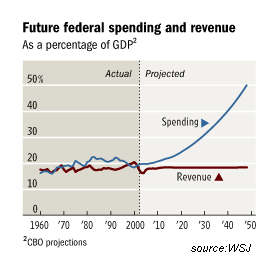
First up is astute reader Greg B., who questioned the moral basis for high taxes: I began reading your blog because I agreed with your thesis that the Federal Government was the cause of most of our problems (too low Fed Fund rates, loose lending standards, excessive spending, etc.)Excellent point, Greg, for "no taxation without representation" lies at the heart of the American Republic. We the people have the right to set our own taxation, and to direct or approve the spending of that taxation. This is a key moral foundation of our Republic. What I should have said was something like this: I morally object to borrowing trillions to pay benefits to ourselves and then offloading the payment of that debt to our children and grandchildren. What we as a people seem to want (based on the gutless "leaders" we elect to high office) is low taxes but plump entitlements--in other words, we want to have our cake and to eat it, too. Of course no nation can offer its citizens low taxes and rich entitlement benefits, and so we have collectively borrowed trillions of dollars in the form of Federal borrowing to make up the difference. But all debt carries interest, and an astounding $192 billion already goes to pay interest on the $8 trillion in Federal debt we've borrowed to balance our national income with our desired benefits. Please see the chart above for the train wreck which lies just ahead and read an earlier entry on The Real Federal Deficit: $2.3 trillion a Year (June 2005) As for the interest payments on that stupendous debt, according to the Federal Government, it now totals $405 billion a year. About half of this is transfers within the government, "paying interest to itself," but the outlays to outside holders of debt are nearing $200 billion a year. That's more than half of Medicare's $390 billion budget. Yet no one squawks at all about this massive transfer of funds to support deficits--deficits which are sure to climb as out-of-control entitlement spending leaps with Baby Boomers' retirement. We want Free Enterprise and low taxes when we're making money, and Socialism when it comes time to collect "our" Social Security and Medicare benefits. Let's face it: Social Security was always a generational 3-Card Monte gamble. When it started, there were something like 40 workers for each retiree; now that's down to about 3 workers per retiree. The gamble depended on ever rising numbers of workers entering the system to keep the retiree-worker ratio high. The Baby Boom enabled the system to continue for decades, ballooning the workforce with its huge cohort of 70 million, but now that the "pig in a python" (the 70 million boomers) is set to retire, the ratio will slip to an unsustainable 2 workers for every retiree. Back in the '30s, when Ma and Pa Kettle retired at 65, they lived to 67 (actuarily) or so before going to their rewards. Now we retire at 62 and live to 82. It doesn't take much common sense to see that a system set up for a few years of modest retirement cannot possibly carry retirees for decades. For more on this subject, please read two books on my Recommended List: Fewer: How the New Demography of Depopulation Will Shape Our Future The Coming Generational Storm: What You Need to Know about America's Economic Future And don't even get me started on the SSI "crazy money" and all the other welfare programs which have been offloaded onto Social Security to tap all those surpluses without having to allot discretionary funds. The system is set to implode, and I am skeptical of claims that all is well until 2060. Recall that the Social Security surpluses are being spent on other Federal spending, so once the surpluses vanish (which will be soon), then the shortfall will come from the same source we depend on so mightily: borrowed money, mostly from the rest of the world. Yes, there is a moral imperative for the government to justify its taxation and spending, but there is also a moral imperative for the citizenry to not offload its own profligate spending onto future generations. Thank you, Greg, for bringing the moral aspects of taxation to the fore and making me clarify my own position. Nexr up, frequent correspondent Michael Goodfellow asks for data on the total tax burden, and for some accountability on spending: You'd really have to include state and local taxes in your effective tax rates, especially if you are going to compare internationally. The U.S. states are as large as many countries, and provide a significant portion of services.Fortunately, correspondent U. Doran supplied this account of our total tax bill, including state and local taxes; by this reckoning, we already pay 54%: How much tax do we really pay? Next up: correspondent Paul M. politely calls me to account for my claim that Medicare spending surpasses the gross mismanagement of funds within the Pentagon: I must take issue with some statements you made about our deficit in your January 19, 2007 entry, the most unsupportable one contending:Thank you, readers, for sharpening the issues and providing excellent data on tax-related issues. I will take up Paul's question about Pentagon and Medicare waste tomorrow. January 19, 2007 Tax Rates: Are The Rich Really Different? In response to yesterday's entry on maximum tax rates, knowledgeable reader Michael M. noted that the more telling statistic is the effective tax rate: (i.e. what people actually pay) As a tax professional I can assure you that comparing highest statutory income tax rates year over year is meaningless. A better comparison would be average effective tax rates for example or gross income tax receipts in real dollars.Michael was kind enough to send over some links to CBO (Congressional Budget Office) data: CBO Publications Here is the link specific to the historical average effective tax rates from 1979 to 2001: Effective Federal Tax Rates, 1979-2001 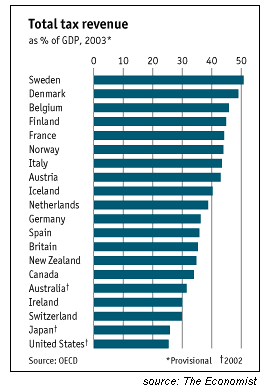 The top 1% had an effective rate of 37% in 1979, which dropped a bit to 33% in 2001.
The bottom 20% paid 8% in 1979 and 5.4% in 2001. In other words, everyone's effective
tax rate dropped by about 2% or 3%. That's about a 10% drop for the top 1% and a 30% decline
for the bottom 20%. Sounds good, but then if your tax bill was $500, a 30% drop works out
to $150. Not bad, but not much. If your tax bill was $5 million (remember we're talking
about the 1% who owns 60% of all productive assets in a $13 trillion economy with a net worth
around $50 trillion) then a 10% drop in your tax rate comes to $500,000. Not much if you
own tens of millions in assets, but nothing to sneeze at, either.
The top 1% had an effective rate of 37% in 1979, which dropped a bit to 33% in 2001.
The bottom 20% paid 8% in 1979 and 5.4% in 2001. In other words, everyone's effective
tax rate dropped by about 2% or 3%. That's about a 10% drop for the top 1% and a 30% decline
for the bottom 20%. Sounds good, but then if your tax bill was $500, a 30% drop works out
to $150. Not bad, but not much. If your tax bill was $5 million (remember we're talking
about the 1% who owns 60% of all productive assets in a $13 trillion economy with a net worth
around $50 trillion) then a 10% drop in your tax rate comes to $500,000. Not much if you
own tens of millions in assets, but nothing to sneeze at, either.
Tax cuts have clearly cut everybody's taxes. Fair enough. But if Social Security and Medicare go belly up or get slashed to the bone, who gets hurt? Not the top 1%. Taxes sound boring, but they're as important as the spending side of the ledger. Look carefully at the chart in yesterday's post and say we're not facing a monumental deficit crunch. We are. Now take a look at this chart of taxes paid as a share of various nations' GDPs and note that we're at the bottom, along with Japan. Now Japan has a Defense Force, but the U.S. has a global military with bases in dozens of countries around the world. The U.S. spends roughly as much on its military as the rest of the world combined, so you have to wonder how we can carry such a burden and yet pay no more than Japan, percentage-wise. It is also worth noting that if we paid a bit more, say as much tax (as a percentage of GDP) as our neighbors to the north (Canada) or our confreres to the far south (Australia), we wouldn't have monstrous deficits as far as the eye can see. Various pundits are happy to "eliminate the deficit" by cutting military spending in half. Nice, but get real. It isn't that easy. If your buddy or son or brother is the one flying the plane or on the ground, you want the best for them, and the best is expensive. Yes, there is massive waste in Pentagon spending, but probably less than in Medicare. Yet it is a rare pundit who breezily advocates cutting Medicare in half to "eliminate the deficit." I would say we get more for our money with the Pentagon than we do with Medicare. And by the way, Social Security and Medicare together dwarf military spending. You can't solve the deficit crises looming just ahead by cutting an aircraft carrier or two. You either raise more revenue (taxes) or you take an axe to Social Security and Medicare. There is no Plan B. One last observation: if you know any Swedes or Danes (we have friends in both countries) then you know they get along quite well paying about 50% of their incomes in taxes. If you're a working parent, there's no comparison; you want to pay the 50% tax and get childcare paid/subsidized by the government. I know the low-tax propaganda machine has brainwashed the vast majority of Americans, but it isn't that simple. In fact, it's kind of like claiming you're going to cut military spending in half, presto-magico. January 18, 2007 How Close Are We to Recession and a Bear Market? How Close Are We to Recession and a Bear Market? Analyst U. Doran and frequent contributor Jed H. have supplied links to cogent analysis. Many of you may have already read these stories, but if not, they are chockfull of persuasive charts. Some readers expressed skepticism about my reference to higher personal income tax rates in the 1950s. Knowledgeable reader James C. was kind enough to supply the IRS statistics: Personal Exemptions and Lowest and Highest Bracket Tax Rates, and Tax Base for Regular Tax, Tax Years 1913-2005, which show that the highest tax rate in the 1950s was not 70% as I stated but 91%. 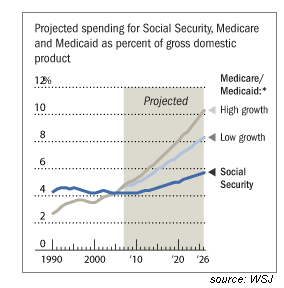 And even as Fed Chief Bernanke warns of catastrophic Federal deficits looming just ahead,
we're bombarded by claims that low taxes are the key ingredient to prosperity.
Perhaps, but then how do you explain the great Bull market from 1946 to 1966? According to the
low-tax rate Jihadists, we should have all been reduced to abject poverty by those high tax
rates. Maybe it's the crushing interest payments on the trillions in Federal debt the low-tax
rate Jihadists have saddled us with in the past 6 years which will impoverish the nation.
And even as Fed Chief Bernanke warns of catastrophic Federal deficits looming just ahead,
we're bombarded by claims that low taxes are the key ingredient to prosperity.
Perhaps, but then how do you explain the great Bull market from 1946 to 1966? According to the
low-tax rate Jihadists, we should have all been reduced to abject poverty by those high tax
rates. Maybe it's the crushing interest payments on the trillions in Federal debt the low-tax
rate Jihadists have saddled us with in the past 6 years which will impoverish the nation.
And now, on to the recommended analyses: U. Doran (see his own analyses in the Gold Eagle archives) sent in a number of recommended stories. Here is a bullish take on the stock market: The Permanent Income Hypothesis And three bearish ones: 25 Year Stock Market Top VIX (volatility) at record low Recession Is Coming Plus a history of the Federal Reserve (neither Federal nor a Reserve--worth reading): Secrets of the Federal Reserve Jed H. sent in this well-documented call for a Bear Market: 7 Reasons To Sell As a lagniappe, here is a commentary on manufacturing employment and automation by frequent contributor Michael Goodfellow: You should certainly distinguish between a company that fires people because it has moved a plant to China, and a company that fires (or probably just doesn't hire) because it has increased its use of automation. Anecdotally, just watch "How It's Made" on the Discovery channel, and note how infrequently anything is done by human beings.Thank you, readers, for a treasure of informative links and comments. January 17, 2007 Four Snapshots of U.S. Manufacturing Frequent contributor Albert T. found some fascinating Census data on manufacturing and finance/insurance employment in New York. Lately I had been thinking that the best business is to mind your own business, so took a look... Basically I took a look at NY State manufacturing and finance and insurance from economic census of 1997 and 2002:Thank you, Albert, for this snapshot. What else can we discern in the data? Since everyone's in a hubbub over declining manufacturing, let's observe that NY State manufacturing employment declined by 145,000 jobs from 1997 to 2002 (a recession, year, we should note) or by 18%--a hefty drop. But as the figures reveal, employment in finance and insurance offset the losses with a gain of 170,000 jobs (a 28% rise), so that total payroll (adjusted for inflation) stayed about the same. How many of those jobs in finance and insurance are housing-bubble related? probably a significant number. The outlines of the next recession are visible if those 170,000 jobs vanish along with the housing boom. It's also interesting to note that total payroll didn't rise much, suggesting that the "boom" of the past six years has not been one of rising employment or wages but a paper money boom of asset inflation and derivative trading. Next up is Adam Florzak's blog entries on Home Depot moving the Ridgid tool factory from the U.S. to China. (Thanks, Bob Nardelli, he of $210 million "golden parachute" fame.) Adam is a very smart young man who I have mentioned in the past, and I highly recommend his recent blog entries on Ridgid Tools and Home Depot. What Adam found in comparing prices between the crappy offshore tools made under the Ridgid brand for Home Depot and the quality tools made by U.S. maunfacturers in the U.S. (Skill and Milwaukee) amounted to $10 or $20--not much over the life of a tool.  As I have stated before: this illustrates that much of the gains made by offshoring U.S.
manufacturing have flowed to corporate profits, not consumers. We are fed ad nauseum
the line that offshoring has been such a boon to U.S. consumers, yet why have corporate
profits run up to a gargantuan, record-breaking percentage of U.S. GDP (see yesterday's entry)
even as wages and benefits have fallen (as a percentage of GDP) to 40-year lows? Is there
any connection to the offshoring of U.S. manufacturing and these immense profits? Gee, do ya
reckon? That isn't the entire profit picture, to be sure, but it's certainly part of it.
As I have stated before: this illustrates that much of the gains made by offshoring U.S.
manufacturing have flowed to corporate profits, not consumers. We are fed ad nauseum
the line that offshoring has been such a boon to U.S. consumers, yet why have corporate
profits run up to a gargantuan, record-breaking percentage of U.S. GDP (see yesterday's entry)
even as wages and benefits have fallen (as a percentage of GDP) to 40-year lows? Is there
any connection to the offshoring of U.S. manufacturing and these immense profits? Gee, do ya
reckon? That isn't the entire profit picture, to be sure, but it's certainly part of it.
Next up: the other side of the outsourcing story: The Spin Cycle of Outsourcing: A consultant tells the other side of the story (S.F. Chronicle Magazine). Confounding easy expectations, the insider/writer of this report says that the most profitable factory in a global tech company with manufacturing all over Asia is in Silicon Valley. It's not just the (lower) cost of wages, in other words, which make manufacturing profitable. Last up is my own anecdotal story about a factory in Hampton, Iowa. On a recent visit to the northern Iowa town of Hampton (my one-stop "international book tour"--what did you expect from an unknown "eccentric"?), one of my guides took me to a plant outside town which manufactured a specialty-coated glass. The coating required high-tech ovens, and it wasn't difficult to see why offshoring the plant made little sense: glass is very heavy and easy to break, and the manufacturing process requires expertise with giant machine tools and ovens. Moving such a factory to China might save some on wages but that would be offset with high shipping costs, breakage and months-long delivery delays. The point: a significant percentage of manufacturing cannot be offshored for reasons other than wages. But we don't hear much about these successes, do we? Lastly, a personl comment from Albert on debt and spending. Albert is a young person just out of college, and his comment provides a window into the seductions of "cheap" debt: We are entering an interesting time, when those who had illusions are drinking sand and checking into reality. I hope the bankruptcy provisions are reversed but in trade off there will probably be an extension from 7 years to 10 years or some other retribution. I am so sad to see my friends delude themselves, one went into real estate mortgage brokering the other started drinking from the debt fountain and can't contain himself. Perhaps this is a lesson in life which will temper their learning for the future. Everyone around seems caught in some sort of irrational behavior enabled by the surroundings. My friend proudly told me that he spent 1500 dollars in 3 days just on going out, clubbing, social status stuff in the spur of the moment. Pehhaps everyone spends the same just I am poor, or do not spend what I don't have. January 16, 2007 Wealth Distribution My entry on wealth and kleptocracy drew two worthy responses. Frequent contributor Michael Goodfellow gently suggested that presenting data to back up my assertions about higher tax rates in the 50s would have strengthened my case, and I agree; I'm working on assembling some income and wealth distribution data. Here is my first presentation of one well-known nation's wealth distribution: 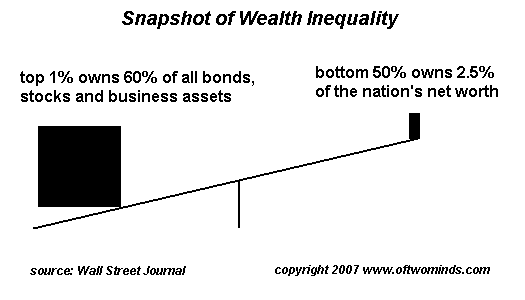
Astute reader Jim M. sent in this response to my query, "Could someone explain the difference between the kleptocracy in Iraq and the African kleptocracies so roundly criticised in the West?" There is a story (probably apocryphal) of an African potentate who visits a Japanese politician's luxurious home and asks, "How can you afford this on your government salary?" In response to which the Japanese points out through the window and replies, "See that expressway out there?"Well put, Jim. Which brings us to the chart above. I think it fair to say that one key gray area is the expectations of a nation's populace and their perceptions of fairness and the opportunity of those in the bottom half to join the top 1% which owns the vast majority of the nation's wealth-producing assets. What nation does this chart describe? Guess carefully. It is a large nation, not some sliver of a country with 5 million people. Here is another factoid about that nation's wealth and income distribution: one of the nation's largest companies, with 234,600 fulltime employees, recently set aside $30 million to reward those 234,600 workers for customer service. The company's chief, meanwhile, earned $240 million over the past 6 years, and recently walked away with another $210 million. That's a total of $450 million in "compensation," or 10,000 times the nation's median household income. Here's another clue: Corporate profits jumped 21.3 percent in 2005 to $1.35 trillion. Profits have been boosted by strong productivity gains and low wage growth, and now account for their largest share of national income in 40 years -- 11.6 percent. The share that went to wage and salary earners, however, sank to 56.9 percent in the fourth quarter -- a 40-year low. And one final clue: The folks at the top of the income heap in the mystery nation each "earned" a staggering 8,000 times as much as the median family income. Did you say Brazil? China? India? Good guesses, but the answer is the U.S.A. Is this a fair or equitable distribution of wealth? I have no idea, but I suspect it is at odds with what the average American believes about the nation's underlying fairness. Can a poor kid from nowhere rise up to Wall Street's pinnacle and "earn" $360 million a year? Perhaps. But the question also arises, should anyone "earn" $360 million for producing nothing, creating no new product or service, coming up with no innovation, etc.? The shades of gray are getting darker, as I think the data suggest. Here are the sources: Wealthiest American Families Add To Their Share of U.S. Net Worth (Wall Street Journal) In 2004, the wealthiest percent owned 70% of bonds, 51% of stocks and 62.3% of business assets. Families in the bottom half saw their share fall to 2.5% of net worth in 2004 from 2.8% in 2001. Profits surge to 40-year high (Marketwatch.com) From the U.S. census Bureau: After falling for five years, inflation-adjusted median household income rose 1.1%, to $46,326.Barrons Up and Down Wall Street (Dec. 11, 2006): Fred Hickey, proprietor of the wonderful High-Tech Strategist and member of the Barron's Roundtable, muses on the disconnect between Wall Street and the real world, like Nashua, which he calls home. The differences have never been greater, he laments, and the wealth disparity is at the highest level in history. By way of illustration, he cites the fact that the average pay of the top 126 hedge fund managers last year was $363 million, up some 45% from the year before.Divide $360 million by $46,000 and there you have it. No place like Home Depot (SF Chronicle, Jan. 14, 2007) Why Income Inequality Matters (yahoo.com) And for a skeptical take, here is an article forwarded by Michael Goodfellow: The Income Gap's Credibility Gap (Reason Magazine, Jan. 15, 2007) January 15, 2007 The Economics of Racial Prejudice Today we honor a courageous American leader, Martin Luther King, Jr. It's a good time to recall the economic underpinnings of racial prejudice. To illustrate the economic motivations for what appears to be racially motivated hatred and oppression, let's return not to the Jim Crow South but to bucolic California circa January 23, 1848--the day before gold was discovered. Californios (residents and settlers of Mexican descent) lived, worked and owned property alongside the Caucasian Americans who had first declared the California Republic in 1846 (which lasted 22 days, as unbeknownst to the "insurgents," the U.S. had declared war on Mexico several months earlier.) California's Native American tribes had already suffered from European diseases and the oppression of their Mexican overlords, but the sparsely populated areas of the Sierra afforded them remote places to live far from official control. Gold severely disrupted this bucolic balance. Hispanic residents and gold-seekers were suddenly seen as competitors for gold, and as a result they were told in no uncertain terms to quit the gold fields and relinquish their Gold Country land claims. (It was still OK to have a land claim in dry, worthless Los Angeles, that wretched little collection of shacks down south.) The Indians' enclaves in Gold Country meant they had to be eradicated, too. Bounties were declared on Native Americans, much like bounties on predators and four-legged pests. The news of gold soon brought prospective gold miners from around the globe. Those from Hispanic America were told to go back home; the Chinese were allowed to set up entrepreneural shops in Gold Country and work abandoned claims, as long as they didn't appear to be finding too much yellow metal. But their industry and thrift soon threatened the economic perquisites of the Caucasian Americans, and various laws restricting their ownership, citizenship and rights to emigrate to America were put into law--laws which limited immigration from China until World War II, when it was suddenly viewed as bad form to treat an ally so shabbily. Why were racial groups which lived in relative harmony in bucolic, sparsely populated and poor California suddenly treated with intolerance? To restrict their access to wealth or the means of wealth, to maintain the perquisites of the ruling class, and to limit competition. If a Chinese merchant started offering customers better service at lower prices than the Caucasian shopowner, the solution was obviously to drive the Chinese businessman out of town, or sequester him in a ghetto where he no longer had access to customers other than his own kind (e.g. Chinatown). Much of what Martin Luther King, Jr. sought was, in this view, simply fair access for African-Americans to the economic opportunities and spoils which had been denied since Reconstruction, when fairness, or at least a rough beginning of fairness, had been imposed by an occupying Army. When the North tired of supporting its occupying Army, it withdrew and the rule of law vanished along with that military force. Reconstruction died and oppression of a new and pernicious sort enveloped the South for 100 years. The struggle for equal access to economic opportunities has made great progress, but the guarding of one group's perquisites can play out in numerous ways--racial prejudice being just one of the most egregious. January 13, 2007 A Short Essay on Wealth, or, Is America a Kleptocracy? Covers of magazines often telegraph the end of a trend. The Economist is famous for its covers bemoaning the decline of the dollar, as the dollar inevitably jumps the week after the magazine hits the newstands. Time and Newsweek also tend to highlight a trend at its end, most recently, the housing boom. The Wall Street Journal recently launched a feature devoted to the gaudier displays of the nouveau riche entitled The Wealth Report. I humbly submit this new summit of sycophancy presages the destruction of the very extravagances the column covers. We are so inured to the media's breathless detailing of talentless "celebrities" excesses that this obsession with new heights of conspicuous consumption barely raises an eyebrow. The fact that one of the nation's premier "old line" newspapers has stooped to scoop "news" from the same foul gutter as the lowest levels of television is perhaps the "real news." An obsession with extravagant wealth is not only an American phenomenon. The PBS series China from the Inside (I recommend it) noted that officials and insiders have fled China with $50 billion embezzled from government companies or other public coffers. Knowing as we do that unfavorable statistics are always under-reported in China, let's assume the real number is more like $100 billion. This is not an insubstantial sum. Where has all this stolen wealth gone? Anecdotal evidence suggests real estate in Los Angeles and Vancouver B.C., paid in cash, and the usual array of offshore banks. Not unsurprisingly to those in the know, very little remains in China. The elites in China always maintain a backdoor should their position become tenuous: a child with Canadian or U.S. citizenship, a home in California, Manhattan or British Columbia, and all the personal wealth skimmed off in China's boom safely deposited in the West or offshore banks. Recent reports reveal that the Iraqi leaders placed in power after the U.S. took control absconded with billions, and now reside very comfortably in London. A young man in the PBS program on China who embezzled $500,000 from a government-owned company (and was actually caught, proving he had no guanxi or was incredibly incautious) observed that his theft was remarkably easy; there was no accounting oversight within the state-owned firm. Clearly, a similar lack of control and oversight has plagued the U.S. mission in Iraq from Day One of the occupation. Could someone explain the difference between the kleptocracy in Iraq and the African kleptocracies so roundly criticised in the West? Or the difference between the "bandit state" which is China from other Third World countries in which the elites plunder the "development" loans, the natural resources, the public coffers and every other available source of wealth? A number of Americans recall the 1950s as the heyday of financial security and rock-solid economic growth. Is it coincidence that an individual who earned, say $10 million in that golden time (in 1956 dollars, or about $100 million in today's money) would have paid 70% or $7 million in Federal income tax? Yet how many of the financial moguls, hedge fund managers and cashiered CEOs who take home "compensation packages" of $100 million or more are paying $70 million in Federal income tax? Memories of what made the 50s a boomtime are indeed selective. Income disparities were much flatter, corporate taxes were much higher as a percentage of GDP and tax receipts, and the tax rates paid by high-income earners were much higher. Yet in today's America, corporate taxes (which recently declined as a percentage of revenues and GDP to all-time lows) and indeed, "confiscatory" personal income taxes on the wealthy, are viewed as the work of the Devil. The 21st century boom, we are constantly hectored, is caused by lower taxes and higher productivity. But if high corporate and personal income taxes are so deadly, then how do you explain the 1950s boom? Did it occur despite higher taxes on wealth, or because of higher taxes on wealth? Yes, I know all the "answers": we had little global competition, etc. But none of those explanations address the domestic economy's health in a climate of higher tax rates on the wealthy. Exactly what did hedge fund traders and the recently fired CEO of Home Depot produce that was worth $100 million each? Profits for their shareholders is the answer, of course, but one has to wonder if these incredible personal "earnings" result from productivity or a barely-cloaked American version of a kleptocracy. Here is the wikipedia definition of kleptocracy. January 12, 2007 Inflation/Deflation V: Bonds and the Dollar Before we get to this chart, let's re-cap the week's entries. 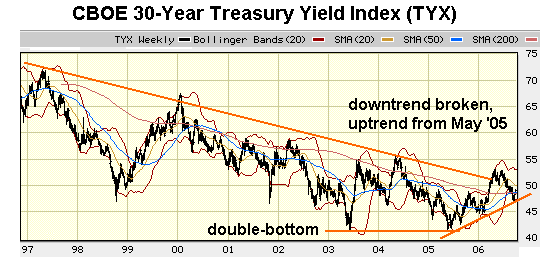
Monday, I suggested that Japan might not be a model for the U.S., as Japan's domestic savings have enabled staggering federal deficits. In nations without savings (the U.S. savings rate has been negative for years), such debt requires enormous capital inflows. To attract that capital and support the currency, interest rates have to be globally competitive. Japan's bond yields of 1% are not competitive. The U.S. does not have the luxury of 1% bond yields. It has dug itself a debt and a dependency on foreign capital which precludes uncompetitive yields. Tuesday, I covered how and what you measure will define whether you get the "answer" you seek on deflation/inflation. Statistics could indicate price deflation even as real-world families find prices for essentials are rising as prices for non-essentials are dropping. Measurements of CPI are based on prices of discretionary items, not just on what you have to buy to live. If you no longer make discretionary purchases, then the advertised "deflation" has no meaning. Various absurd distortions in the weighting of housing and healthcare render such measurements utterly unreliable. Wednesday, I pointed out that the "low hanging fruit" of deflationary pricing from China has all been picked; Chinese producers are squeaking by on razor-thin margins. If prices drop from here, they will be driven out of business by losses. Losses eliminate competition which then eases deflationary pressures regardless of money supply expansion or contraction. The real world measures deflation-inflation in prices moved by supply and demand; monopoly capital sets prices to remain profitable. Asset deflation can continue for a long time, but consumer pricing deflation soon reaches an end point. Thursday, I posted charts which showed gold has outperformed all major stock indices since 2002, and suggested that gold, as a hedge against either inflation or economic uncertainties, did not seem to be predicting a deflationary environment--unless that means a global flight from all paper assets in all nations. Today we look at U.S. Treasury bonds--which means we also look at the dollar. The deflationary camp generally holds that Treasuries will prove to be a wonderful asset to own, as yields (interest rates) will decline a la Japan circa 1990-2006. As yields drop, the value of current bonds rises in proportion. A bond yielding 6% will roughly double should yields drop to 3%. But history suggests yields will rise for another 15 years--rendering Treasuries an asset which will be in massive decline for years to come. 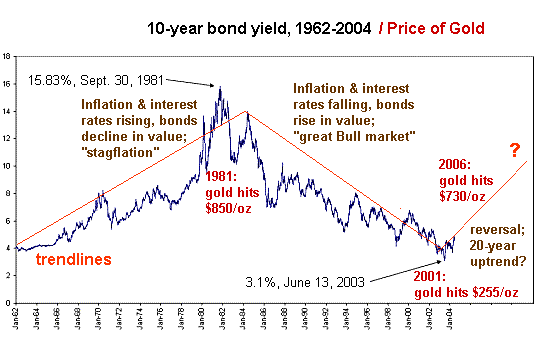
This chart suggests bonds operate on cycles of about 20 years. The cycle of declining yields (1982 - 2003) is over. The cycle of rising yields has begun. I again want to suggest that deciding "this will happen because I believe XYZ" is unlikely to succeed as an investment strategy. These charts are rather unambiguous, and so the question becomes, what might cause interest rates and yields to rise for the next 15 years? One possible answer is a defense of the dollar. The U.S. has a vested interest in conflicting forces: a dollar which weakens against other currencies will work to reduce the stupendous trade deficit, but a collapsing dollar will remove the "safety" which supposedly motivates foreigners to buy trillions of Treasury bonds (which are of course priced in dollars.) A dollar which drops 50% will also drop the value of bonds held by foreigners by 50%--a loss few are willing to suffer. Here we see a dollar which has weakened considerably even as bond yields bottomed and rose. 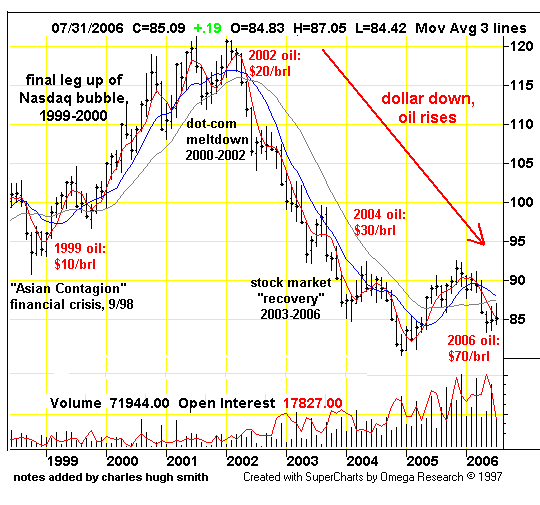
Is it coincidence that gold started outperforming the global stock market shortly after the dollar began its slide? Here is where we see the key difference between Japan and the U.S. The U.S. must defend its currency, as it depends on non-U.S. buyers of its Treasury bonds to fund its trillion-dollar deficits and public debt. Japan did not need to defend its currency, nor tempt foreign buyers to buy trillions of its public debt. This is why I consider the deflation-inflation debate of little value. The U.S. Treasury has to sell $400 billion of new bonds to fund the Federal deficit and another trillion or so of old debt which comes up for renewal every year (Recall they stopped selling the 30-year bond for a few years.) And this is before the Baby Boom retires and the recession of 2007-2012 slashes tax receipts; deficits might rise to unforeseen levels in just a few years, putting even further pressure on the Treasury to sell more bonds on the global marketplace. Whether money supply increases or decreases, whether asset prices deflate or inflate, whether the cost of sneakers declines or rises, the bonds have to be sold. There is no Plan B. Please note the first two charts were of bond yields. As yields rise, the value of existing bonds plummets. As yields fall, the value of existing bonds rise. Here is a chart of U.S. bond values. Note that it dropped to its low when yields topped out in 1981. (Chart courtesy of Harun I.) 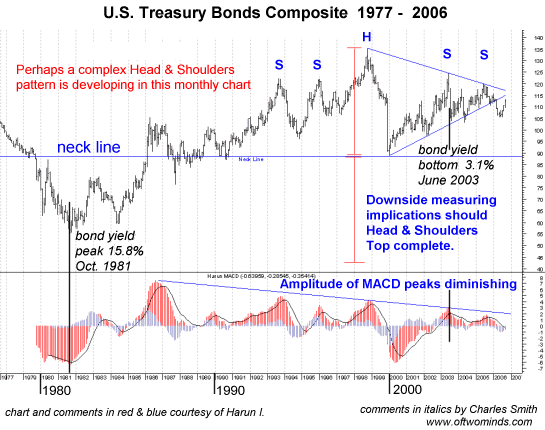
If the wedge formation breaks to the downside (which history suggests it will), the downside target is even lower than the nadir reached in 1981. That would suggest yields might rise even higher than the 16% top hit in 1981. What could cause such an unexpected rise in yields? Let's start with that supposed impossibility, inflation: 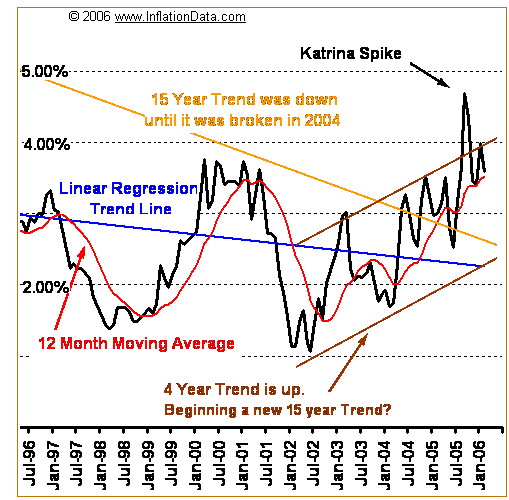
As I have posted before, I see evidence that key non-discretionary sectors--energy and food--could be beset with sharp increases in price due to huge supply-demand imbalances. With supermassive oil fields in Kuwait and Saudi Arabia already in decline, with the mideast looking more like Europe 1914 every day, with China's food supply in decline even as demand soars, as global warming shifts weather patterns into extremes of drought and flood--it takes little imagination to foresee oil rising above $100/barrel and grains increasing in price five-fold or even ten-fold. Copper can tank and steel can plummet, but when push comes to shove, you don't need to buy a new house full of copper wiring or a new car of steel and plastic. But you do need to eat and consume energy--and pay your mortgage and credit card debt. The standard deflationary line is that the world is awash in borrowed cash seeking returns, and there is no better place to park all that money than U.S. Treasuries. In other words, yields will drop because the demand for Treasuries will only rise as times get tough. Let me propose a somewhat different scenario. Let's say an "unexpected" (at least by the usual cheerleaders and media outlets) financial disruption occurs which causes some of the trillions in derivatives to go sour, causing massive selling of the underlying assets to raise cash to reduce margin and other debt. Such a sudden "crisis" could erase trillions from global liquidity. How? Because the money was lost. The derivatives turned out to be worthless, and the stocks and bonds were sold into a plummeting, panicky market. In this scenario, Treasuries would be sold along with every other paper asset in a desperate bid to raise cash to pay off an avalanche of debt being called. (Recall that if you bought a derivative to "protect" your portfolio, and the company on the other end of that derivative folds, you get nada. Meanwhile, the derivative you sold kicks in and you owe someone else billions in "insurance" which you must raise the hard way, by selling assets regardless of how low they've dropped.) So exactly where did the global liquidity go? It vanished in losses. Where did demand for Treasuries go? It vanished, too. As the panic deepens, feeding upon itself as such financial panics tend to do (based as they are on human emotions), then the Treasury auction comes up as usual, every few weeks. Hmm, no buyers at 4.5%. Let's try 6%. Yikes, no buyers; people are still selling hundreds of billions of bonds, not buying. Let's try 10%. OK, a few takers, but we gotta move $500 billion in bonds by tomorrow. How about 12%? You see where this goes. If yields double from 4% to 8%, every existing bond just lost half its value. Now you're getting 50 cents on the dollar for that "safe" Treasury bond, and you decide to sell now before it goes to 25 cents. Alas, so does everyone else. The Treasury has no choice but to jack yields up to whatever it tales to induce panicky buyers to risk cash on a Treasury which could drop the next day or the next week. That's how yields could get back to 16%, and in a hurry. That's how the bond market could be gutted, and trillions in wealth destroyed. Inflation "can't happen." Yields "have to drop." Really? Given the charts above, that sounds more like a religious belief than analysis. If you believe such a crisis is unlikely, please read Benoit Mandlebrot's The Misbehavior of Markets January 11, 2007 Inflation/Deflation IV: Why Is Gold Outperforming Global Stock Markets? Frequent contributor Harun I. was kind enough to send in these charts of various stock indices from around the globe and their relative performance to gold. The most obvious characteristic--which is shared by all of these indices--is the divergence from gold (the ratio of the index to gold) as the indices soared upward. Simply put: all the indices once rose and fell in tandem with gold. The divergence began with the global Bull Market which started in late 2002/early 2003. Even as global stock indices have risen to dizzying heights, they have seriously underperformed gold. Here's how to understand the index-to-gold ratio. Let's say a hypothetical index stood at 1,500 in 1999 and gold was $300 (priced for simplicity's sake in dollars for this example). The ratio would be 5. As the dot-com bubble pushed the index to, say, 5,000, and gold fell to $250, then the ratio rose to 20--tracking the parabolic rise in the index. But the recent "Bull market" has seen the index/gold ratio stay level while the indices rocketed higher. As our hypothetical index rose from 1,500 in 2002 (yes, it retraced from its dot-com glory back to where it started) to 3,000, gold rose from $250 to $600, yielding a ratio of 5--the same level as in 1999, even as the stock index has surged. The flattening of this ratio shows that gold has dramatically outperformed all the major global stock markets since 2002. Take a look at the charts and then catch the concluding commentary. 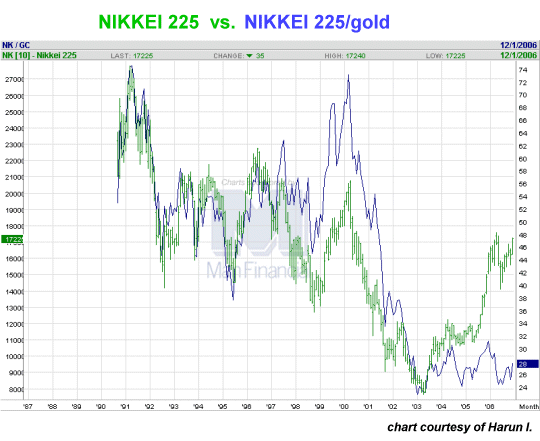
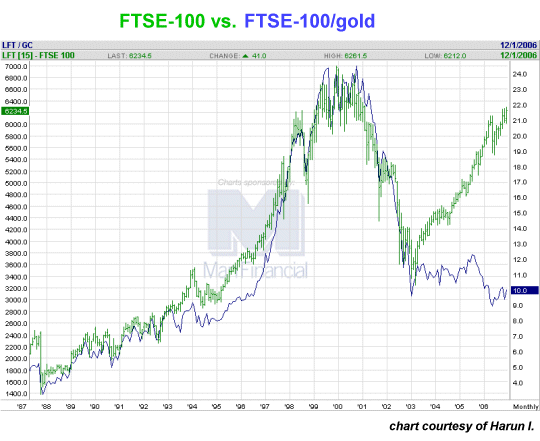
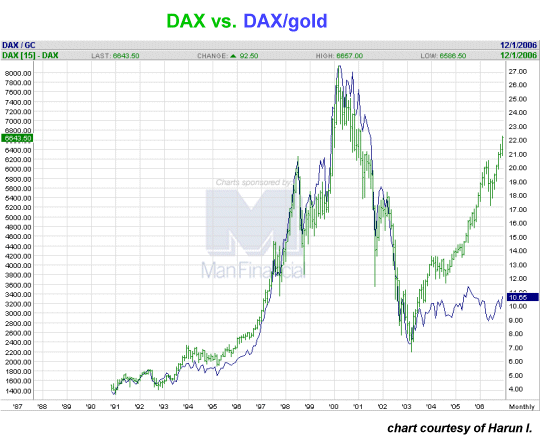
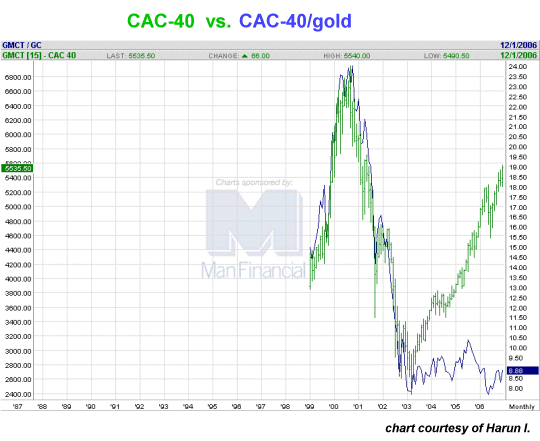
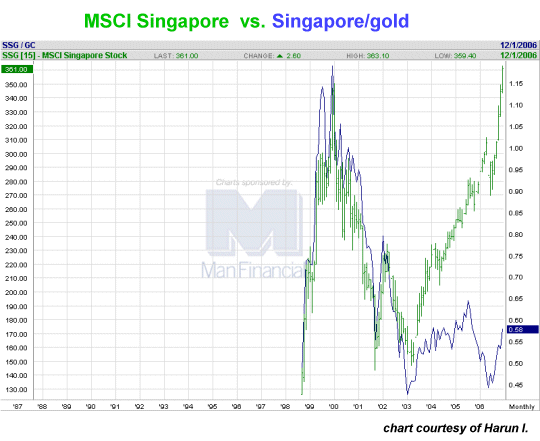
If deflation is about to conquer the global economy, why is gold--that traditional hedge against inflation--outperforming the apparently "golden" stock markets? This is not a rhetorical question; why has the key global hedge against inflation and/or uncertainty been rising steadily for years against all major stock markets in an era of "low inflation" and "low-risk growth"? If we're about to enter a massively deflationary period, then cash will be King. Every month, your cash will buy more of everything than it did the previous month/year. Why would investors be buying gold when cash will be King? Why would gold rise when every other product and commodity can be had cheaper next month? One explanation would be that all paper assets have fallen from favor, regardless of their nation of origin; but what sort of global environment would cause all currencies to be spurned with equal fear/distain? Please note these are non-U.S. indices priced in currencies other than dollars. The argument that gold will be a hedge against a falling dollar explains nothing about these charts. I am not being clever in posing the question. (My heartfelt thanks to Harun for sharing these charts, which if studied with the proper care, will be recognized as valuable guidance.) Gold's rise presages not deflation but either inflation or a massive simultaneous decline in the value of all currencies. There are no other interpretations. Sometimes the best investment strategy is to follow what the charts suggest, and leave the explanations until after the fact. If you decide ahead of time what the working explanation must be (to fit into your belief system or school of economics, etc.), perhaps you're blinding yourself to what is actually unfolding. In other words, gold is outperforming stock markets, even as they rally to new heights. Regardless of the reason, which asset class do you think will outperform in the next 5 years? Are there reasons to believe prices for commodities, goods and services might drop? Sure, in two words: recession and overproduction. But as yesterday's post explained, there are real-world limits (called losses) on how much prices can drop. Prices can only drop until businesses run out of savings and credit. Once the majority of unprofitable businesses fold, competition eases and prices stabilize/rise. Perhaps inflationary pressures are building which could overwhelm the rather modest forces of deflation. After all, how much copper or steel are you going to buy when you decide to cut back and start saving? How much plasticware or tools from China are you going to buy as you stick to a tight budget? Those prices can drop through the floor but if nobody's buying, then who's reaping the "deflationary" prices? Perhaps the items which you have to buy--energy, food and medicine, for instance--are rising, along with the cost of borrowed money (interest rates). But perhaps gold is rising not as an inflation hedge but as "safe money" in a global devaluation of all currencies. Knowledgeable reader U. Doran was kind enough to send this link to a LewRockwell.com piece entitled Gold and Deflation. The author suggests gold is not an inflationary hedge but a deflationary hedge in times of uncertainty and decline (bank failures, etc.). Whatever the reason, gold has been outperforming global stock markets. Perhaps the question should be rephrased from "are we facing a deflationary or inflationary future?" to "what is the best asset class to own over the next 5 - 10 years?" These charts suggest the tangible asset of gold may well outperform all paper assets--stocks and bonds alike. More on bonds and the dollar tomorrow. January 10, 2007 Inflation/Deflation III: The Limits of Deflation On my first visit to China in June 2000, I was surprised to read that overproduction of television sets had driven prices below costs, and manufacturers were teetering on bankruptcy: TV Overproduction Leads to Price War (2000).  As this article describes, the government stepped in to fix prices above break-even, but
no one in the industry expected this to hold.
As this article describes, the government stepped in to fix prices above break-even, but
no one in the industry expected this to hold.
This meant that China was already producing more TVs in 2000 than either the domestic or export market could absorb. So much for U.S. pundits who think China can live without export markets; they are already producing everything far in excess of what their domestic market wants or can afford. Every Chinese family already had a TV in 2000, and everyone who can afford one has a cell phone, too. Welcome to Marx's vision of unbridled Capitalism: stupendous overproduction leads to relentless price cutting which leads to widespread bankruptcy among producers as every market is saturated with goods nobody wants or can afford. Marx correctly described the endgame of price wars: monopoly capital, in which a small handful of surviving producers control each sector market. Here's a news story on overproduction of cell phones back in 2003; inventories of domestic (Chinese) manufacturers were estimated at 20 million phones--never mind Motorola and Nokia's inventories: New rule to curb mobile-phone overproduction (2003). 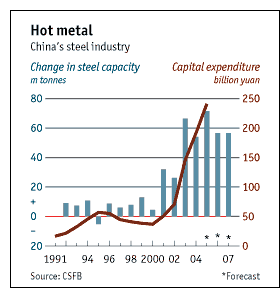 Next up, steel: same story, only more so: 80 million tons of oversupply--again, just
domestically. How about all those nations who've counted on supplying China with steel?
Throw in non-Chinese capacity, and overproduction probably reaches 180 million tons annually:
Overproduction risks loom large in China: expert (August 2006)
Next up, steel: same story, only more so: 80 million tons of oversupply--again, just
domestically. How about all those nations who've counted on supplying China with steel?
Throw in non-Chinese capacity, and overproduction probably reaches 180 million tons annually:
Overproduction risks loom large in China: expert (August 2006)
Over the past six years, the real estate market absorbed nearly 60 percent of iron and steel products. China's iron and steel output for the 2006-2010 period is expected to reach 250 million tons, which would translate into an oversupply of more than 80 million tons, he said.Here are two stories from the People's Daily English language webpage (I had trouble loading these, but give them a try; maybe "The Great Firewall" is overloaded): Government study says 11 Sectors Threatened by Overproduction. Auto Industry Facing Grave Overproduction. What's ironic about the auto overcapacity is that every major auto company in the world rushed to build factories in China for the domestic market, and now, guess what: the capacity far outpaces domestic demand for the foreseeable future. This is the engine of deflating prices: global overproduction on a gargantuan scale. But even with overproduction running rampant, there are limits, and that's what I want to focus on.  It's well known that China has long subsidized its government-owned factories with "loans"
which cannot be repaid. But even the central government's purse is not unlimited,
and China has been closing or selling off these outdated dinosaur factories as rapidly as
possible. (See China: An Interim Report
for more on China's economy.)
It's well known that China has long subsidized its government-owned factories with "loans"
which cannot be repaid. But even the central government's purse is not unlimited,
and China has been closing or selling off these outdated dinosaur factories as rapidly as
possible. (See China: An Interim Report
for more on China's economy.)
In other words, the Chinese government is now willing to let companies go bankrupt. The game for the central government is to keep export markets growing so they can absorb the ever-greater production of China. But a U.S. recession will throw cold water on the fire: their largest single market will spin into declining demand. This will present an insoluable problem, for Chinese factories are already running at razor-thin margins of 5% or less. (As reported in BusinessWeek: Rising Wages Spell Trouble in China. See also my entry, Trade with China: We're Making Out Like a Bandit.)  The net result: a price cut of only 6% puts Chinese manufacturers in the red--and heading
straight for bankruptcy. Chinese entrepreneurs are not foolish; they are not going to
run their businesses at a loss. Some global Japanese corporations have been known to absorb
losses for years to build market share or drive competitiors from the market, but these
companies are extremely well-capitalized and enormously profitable; they can afford to take
the long view. Chinese companies have neither luxury.
The net result: a price cut of only 6% puts Chinese manufacturers in the red--and heading
straight for bankruptcy. Chinese entrepreneurs are not foolish; they are not going to
run their businesses at a loss. Some global Japanese corporations have been known to absorb
losses for years to build market share or drive competitiors from the market, but these
companies are extremely well-capitalized and enormously profitable; they can afford to take
the long view. Chinese companies have neither luxury.
Here in the U.S., prices dropping in restaurants and nail-salons is divined as proof of deflation. But there are limits to price deflation in the U.S., too. Our friends own a restaurant, and used to own two until costs forced then to close one. Restaurants, nail salons, airlines--they all operate on the same principle: your fixed costs are high, so you need to fill a certain number of seats to make your nut, i.e. cover your expenses. Every seat beyond that number is profit. Let's say a restaurant has to serve 300 meals a day at $10 each to cover rent, utilities, employees, TDI, workers compensation, liability insurance, marketing, etc. Now if a recession darkens the land, customers become scarce. If our restaurant owner cuts prices 20%, then they have to serve 375 meals to break even. Customers cut back on liquor, desserts, beverages--all your profit centers. As business gets tougher, you actually have to bring in more customers--basically taking them from competitors, who might well respond by cutting their prices. As losses mount, restaurants are forced to close. You can only keep the doors open as long as your savings (or credit lines) hold out. Once that's gone, you have no choice but to close. One restaurant--the best capitalized, the one which can afford the best marketing, and so on--will remain in each sector, but the rest will be gone. Then the remaining restaurant(s) can raise prices again. Why not? The entry costs are steep, and who is crazy enough to risk opening a business in a recession? The fixed costs are high, even in a declining business climate. Rents don't drop much, and neither do wages, taxes, insurance, etc.) (If you know a commercial landlord who will rent a restaurant space for next to nothing, please let me know. That would be smart, in the long-term, but the majority of commercial landlords will let a space languish empty for years rather than accept a major rent reduction.) The point: price cuts--and thus deflation--will only endure until price wars eliminate the vast majority of competitors. The few survivors will benefit from the same power that all monopoly capital wields--price increases and profitability. While assets may deflate in value for years, consumer prices cannot. Once price wars and losses eliminate most competitors, the survivors must stabilize prices or go under themselves. We need to be careful to specify whether we are measuring asset deflation or deflation in the price of everyday consumer goods. The two are very different. Here are some related entries on China you might want to read: China Irony: Steel, Marx, and Monopoly Capital Will the Housing Bubble Take Down China? Hot-Air Dragon: Is China About to Pop? Astute reader Jill M. sent in this correction to Aaron K.'s commentary yesterday: His mention of the Plaza Accord is quite off base.Thank you, Jill, for setting the record straight on a key slice of economic history. January 9, 2007 Inflation/Deflation II: Is The Answer How We Measure? In one school of thought deflation/inflation can be measured by one simple yardstick: is money supply expanding or contracting? But the real world offers another measure: prices. The rise (inflation) or decline (deflation) of consumer prices is calculated for us, courtesy of the Bureau of Labor Statistics. Here are the numbers used to figure the CPI (Consumer Price Index) (taken from the Bureau of Labor Statistics abstract titled why inflation as stated in CPI doesn't match your reality:) Expenditure category --------------------------------- Food and beverages 15.7 Housing 40.9 Apparel 4.4 Transportation 17.1 Medical care 5.8 Recreation 6.0 Education/communication 5.8 Other goods & services 4.3 --------------------------------- Total, all items 100.0 I have commented at length elsewhere on the obvious distortions inherent in this basket, chiefly that rising mortgage rates and property taxes play no part in measuring housing costs--that number is based on "equivalent rent," meaning what you'd pay in rent for your house. This effectively negates the cost of homeownership for the 69% of the population who "own" their own home (soon to be 64%, as the 5% on the margins fall into foreclosure). Here are the entries should you want more: Why Inflation Appears Low (June 2005) The Housing - Inflation Connection (April 2006) After the Bubble: rents and Housing Values (May 2006) Why Post-Bubble Rents Matter (June 2006) Let's speculate on how a combination of deflation and inflation might effect the CPI. Let's say a recession takes the U.S. economy by the throat in 2007, and builders continue pumping out more housing nobody wants to buy until they finally go bankrupt. Given the low demand (people moving back in with their parents, etc.) and rising supply (thousands of vacant houses and condos) rents might drop 10% nationally, which would by itself cause the CPI to register a 4% decline. Deflation! 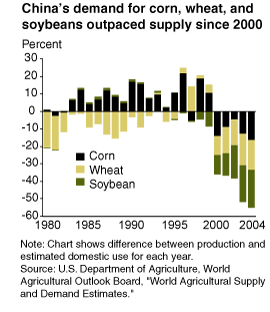 But let's further suppose high oil prices (Kuwaiti and Saudi super-giant fields are already
in permanent decline, don't forget) and a disasterous crop or two in the world's
breadbaskets (note how weird the weather is getting, so don't tell me this isn't possible)
cause food prices to leap 10%. Recall that grain, like oil, is priced on the margins; prices
are set by the last couple million barrels or tons of supply and demand, not the first 95%.
But let's further suppose high oil prices (Kuwaiti and Saudi super-giant fields are already
in permanent decline, don't forget) and a disasterous crop or two in the world's
breadbaskets (note how weird the weather is getting, so don't tell me this isn't possible)
cause food prices to leap 10%. Recall that grain, like oil, is priced on the margins; prices
are set by the last couple million barrels or tons of supply and demand, not the first 95%.
Since food and beverages are 15% of the CPI, a 10% rise kicks it up only 1.5%. But wait a minute. Rents may have dropped, but 69% of the citizenry don't rent. So the benefits of dropping rents don't accrue to them at all. Meanwhile, they are paying higher food prices. Next, let's admit that medical costs are grossly understated by the CPI's 5% allotment. Since medical/healthcare (what should be called sick-care, since so little is spent on health) is 16% of the GDP, maybe it should be 16% of the CPI. Let's assume that these costs continue their usual 10% rise annually. In the CPI as figured currently, this 10% increase only adds a .5% to the overall CPI. So a family with limited or no coverage, or serious medical expenses even after co-pays, is paying out thousands of dollars more than in previous years, but the CPI barely registers a blip. You see the point. Rents could drop even as food and medical expenses soar, and the CPI would register a 2.5% decline. See how meaningless this statistic becomes in terms of' measuring deflation and inflation? Two-thirds of the population are not paying less for housing, and they're paying a lot more for food and healthcare, yet they're told by the media and the government that they're living in a deflationary economy. The folks who ardently believe inflation and deflation are merely matters of money supply forgot basic economics: supply and demand set prices. Put another way: you can print or create more money, or print less money, but you can't print more oil. When oil supply falls beneath global demand, prices will rise, regardless of whether M2 or M3 money supply is shrinking (deflation, according to theory). Ditto for grain. You do have to eat, and where you get the money to pay for food is not the market's concern. Demand for grain and oil are not as elastic as theory would have it, and history shows that shortages of both appear quite regularly, with the result predicted by supply and demand: prices skyrocket. That's called inflation, because you're getting the same product and paying more money for it. Money supply has nothing to do with it. The point: statistics do not reflect the realities of rising or falling prices, so we should be careful before announcing either "deflation" or "inflation." A small example: every European knows that prices rose when the euro currency was established. yet "official" statistics say prices didn't rise. Was the euro inflationary? Well, you got the same cafe au lait but you paid more for it. Frequent contributor Aaron K. sent in a cogent description of the "Japan carry trade" which I reprint here as one of the most concise I've ever read. Here are some links to previous entries on Japan's staggering debt: Japan's Runaway Debt Train (2001) Tale of Two Debts: Japan and the U.S. (October 2006) Here's Aaron's commentary: Great piece on Japan. All those things you discuss are surely factors in Japan's condition. But I must say there is one important thing you missed.Thank you, Aaron, for this excellent description of the carry trade and its pernicious affect on the U.S. economy. January 8, 2007 Inflation/Deflation I: Is Japan an Accurate Model? 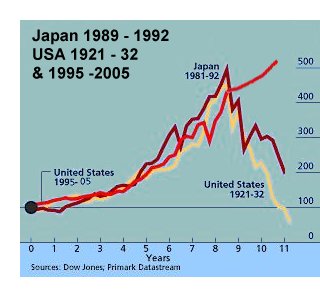 Knowledgeable reader Cheryl A. was kind enough to ask me to weigh in on the "will the
near future be inflationary or deflationary" question:
Knowledgeable reader Cheryl A. was kind enough to ask me to weigh in on the "will the
near future be inflationary or deflationary" question:
I was wondering if you would consider discussing why some experts/ authorities believe the future will be inflationary while others see it as deflationary. John Williams is now projecting it will be hyperinflationary. 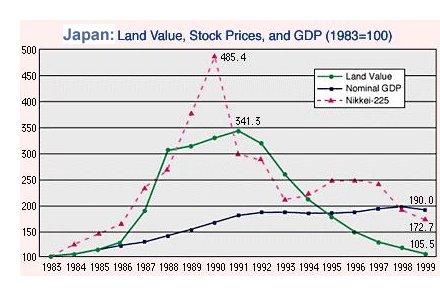
An astute question on a confusing--and for investors--"gotta get this right" topic. My responses will take the entire week, and will hopefully yield conclusions I haven't read elsewhere, though no doubt many others have followed the same trails. Although it may seem odd to start the discussion by considering Japan, it's the logical starting point because so many deflationists (such as the esteemed Mish) point to Japan as the model the U.S. will follow as it slides down a deflationary path. As a non-believer in any economic school--Austrian, Chicago, etc. etc.--I am not looking for evidence to support my belief system. Japan is a highly complex society and economy, the world's second largest despite a decade of relative decline. Care must be shown before jumping to conclusions about anything within Japan, because the surface may not be the reality. Long-time readers know that we maintain a large circle of personal friends in Asia, stretching from Thailand, Indonesia and Singapore to China, Korea and Japan, where our friends number in the dozens. As a result, my understanding has been informed by experienced insiders. If you think you can grasp Japan via a dry paper or two by a stateside "expert," you are sadly mistaken. (Though I did study the language, geography, literature and society in my university days.) This is a warning to anyone seeking a simplistic answer to the deflation/inflation question: it isn't simple. For an example, let's turn to some snapshots of Japan. Our first chart shows the asset-inflation bubble which rose in Japan's "easy money" 1980s and subsequently collapsed, like all such asset bubbles--as shown in the second chart. Here we see that land values rose with the stock market, and then fell, in a long slow slide, to a full-retrace, i.e. a return to the pre-bubble valuations. Meanwhile, the GDP traced a nearly straight line even as asset prices plummeted. This chart shows asset inflation and then deflation on a grand scale. So let's ask: what conditions were present which were unique to Japan which may not be present in the U.S.? 1. Japanese debt, corporations and their interlocking ownerships are not transparent. While much has been made of the past decades' "reforms," only a fool would claim Japan's debt and corporate structures are now as transparent as those in the U.S. As I have documented elsewhere (see Archives, "Unfolding Crises: Asia"), the true size of bad debt in Japan remains unknown, as so much bad debt (i.e. uncollectable loans lacking collateral) remains on the books as loans in good standing. The underlying health of Japan's financial system remains suspect. 2. For cultural reasons, houses depreciate from the moment they're completed, regardless of what land values do. In Japan, houses are routinely pulled down after 30 years and replaced. If you buy a house and the land beneath it, the value is reckoned much as property tax bills are figured in the U.S.: one value for the house, one for the land. The house will lose value every year regardless of inflation or deflation. 3. The Japanese countryside has been losing population for decades. On my first visit to rural Japan in 1992, I was surprised to see abandoned schools, and to meet Japanese farmers married to Sri Lankan women. Gaijin (foreigners) are rare in the countryside, but less so nowadays, as Japanese men are finding it difficult to find Japanese women willing to live and work in farm country. As a result, they're seeking wives from elsewhere in Asia. The U.S. has also experienced a decades-long exodus from rural counties, but the property bubble in Japan reached far deeper into the countryside than the U.S. bubble has. According to blogger Fred Roper in Oklahoma City (see his Satellite Sky blog in the right-hand column), you can still buy a decent house in a decent neighborhood in Oklahoma City for about $100,000. This supports the notion that the housing bubble in the U.S. remains a coastal phenomenon.  Part of the reason behind Japan's rural bubble lies in the political structure of its government.
Rural representatives retain far broader powers than in the U.S., and the subsidies ("bridges to nowhere"
like the one in Alaska which excited such outrage in the U.S.) have been far more egregious
than in the U.S. The point: conditions unique to Japan boosted land prices in rural
Japan to a degree which is not present in the U.S. The decline in rural asset prices
was thus exacerbated by these distortions.
Part of the reason behind Japan's rural bubble lies in the political structure of its government.
Rural representatives retain far broader powers than in the U.S., and the subsidies ("bridges to nowhere"
like the one in Alaska which excited such outrage in the U.S.) have been far more egregious
than in the U.S. The point: conditions unique to Japan boosted land prices in rural
Japan to a degree which is not present in the U.S. The decline in rural asset prices
was thus exacerbated by these distortions.
4. Japan is losing population as a result of a birth dearth. Here is a delightful photo of our friend's two nieces. As I make a mental list of about 20 young women between 24 and 35 whom we know, I realize only four have children. Now perhaps a few more will have children later in life, and perhaps this group of women is not representative; but this suggests a staggering reduction in young women's willingness to bear children (or even get married)--a trend which statistics confirm. The point is obvious: a declining population feeds land and housing deflation, as there is less demand for housing every year. 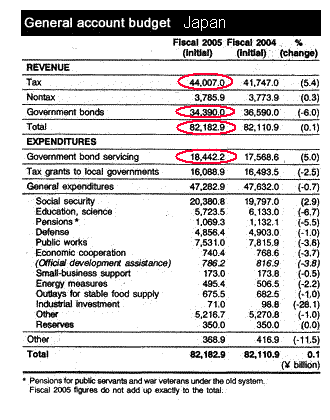 5. Despite its ballyhooed "recovery," Japan continues to depend on deficit spending to
an astounding degree. Note that bonds, i.e. new government debt, is fully 42% of
the central government's "revenues." Even though the interest rate on thse bonds is a pitiful
1% or so, the interest payments still consume 22% of the federal budget. What would happen
if Japan was forced to live with a balanced budget? Or what if interest rates rose to
5%?
5. Despite its ballyhooed "recovery," Japan continues to depend on deficit spending to
an astounding degree. Note that bonds, i.e. new government debt, is fully 42% of
the central government's "revenues." Even though the interest rate on thse bonds is a pitiful
1% or so, the interest payments still consume 22% of the federal budget. What would happen
if Japan was forced to live with a balanced budget? Or what if interest rates rose to
5%?
The point: Japan has been living far beyond its means, depending on the surplus savings of its citizens, and their willingness to accept pathetic rates of return (1%) on those savings. Despite a decade of "pumping" (low interest rates, deficit spending, etc.), the government itself is totally dependent on deficit spending to fund typical government functions. The point: Japan can pursue the folly of massive government deficit spending indefinitely because its populations saves prodigiously and is willing to accept near-zero returns. The ultimate wisdom of piling mountains of debt onto a shrinking future generation is suspect, and it this regard Japan has failed to reform the key issue: the generational transfer of debt service to the future taxpayers. 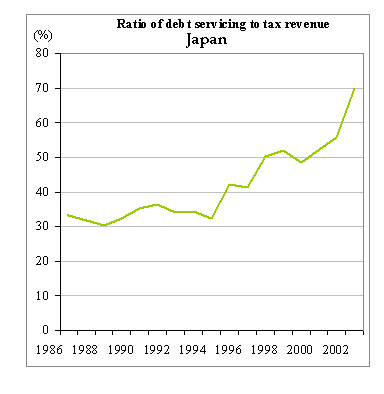 6. Despite reforms, Japan has enormous sources of more-or-less enforced savings.
Residents had few options for savings other than postal accounts, and even though some of
these restrictions have been lifted, the government was able to tap this vast pool of
domestic savings--and the Japanese remain prodigious savers--while paying virually nothing in
the way of interest. There are cultural considerations here which cannot be quantified;
Japan is a conservative society and people continue to save in traditional fashion despite
new opportunities. Furthermore, many people still recall losing vast sums in the stock
market bubble and thus continue to save in traditional postal or bank accounts.
6. Despite reforms, Japan has enormous sources of more-or-less enforced savings.
Residents had few options for savings other than postal accounts, and even though some of
these restrictions have been lifted, the government was able to tap this vast pool of
domestic savings--and the Japanese remain prodigious savers--while paying virually nothing in
the way of interest. There are cultural considerations here which cannot be quantified;
Japan is a conservative society and people continue to save in traditional fashion despite
new opportunities. Furthermore, many people still recall losing vast sums in the stock
market bubble and thus continue to save in traditional postal or bank accounts.
As this chart shows, a stunning amount of Japan's tax revenues now goes just to service debt. So what are the conclusions? We should be careful not to assume Japan's property bubble parallels our own; while all bubbles share certain characteristics, they do not necessarily share the same conditions. For instance, political and financial distortions and long-term population trends are quite different in the U.S. than in Japan. Despite the rah-rah about Japan's "recovery," the Japanese government's finances remain dependent on massive new debt--a stunning generational transfer of ever-rising obligations. The fact that Japan can continue a "prime the pump" strategy of low interest rates and massive deficit spending does not mean they have successfully reformed the distortions and bad debt within their financial system. The system relies on an enormous pool of domestic savings which is restricted--in cultural and regulatory ways--from seeking higher returns overseas. The U.S. should be so "lucky." January 5, 2007 Charting Housing's Dead-Cat Bounce: LEN and TOL Another way of identifying housing's recent rise as a dead-cat bounce is to look at some charts of leading housing stocks: Toll Brothers (TOL) and Lennar (LEN). After noting my disclosure about being short TOL, frequent contributor Jed H. recommended LEN as a promising short as well. So let's look at their 3-year charts: 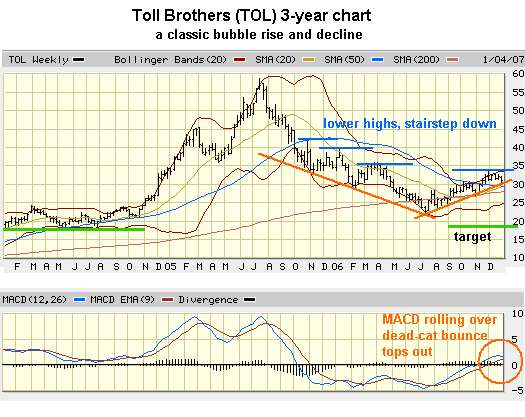
Compare the basic shape of TOL's meteoric rise and fall with the chart of Nasdaq's dot-com bubble in the January 3 entry below. Even this "recovery"/dead-cat bounce matches the classic bubble shape exceedingly well. The end result, however, is already being telegraphed by price weakness and the rolling over of MACD--a return to pre-bubble valuations. 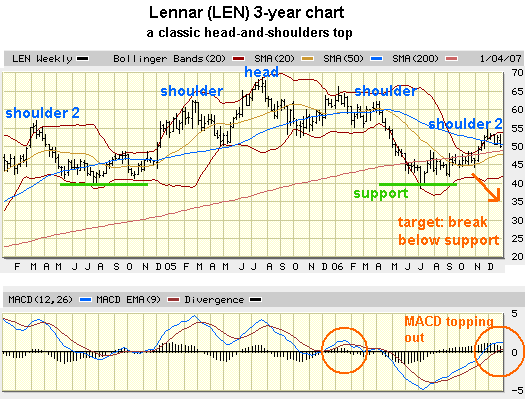
LEN exhibits another classic pattern in technical analysis, the head-and-shoulders top, in which previous support levels are held for some time before the stock falls to lower support in a gradual stairstep down. The next support for LEN is $40, but neither the chart nor the fundamentals of the housing market provide much evidence that this price level will hold for long. Once it breaks below $40, the target could be much lower; Jed. H. suggested the low 20s as a potential target, and given that the housing bubble has only started a multi-year decline, this seems reasonable. January 4, 2007 Will Thailand Lead the Global Economy Down--Again?  Some chartists discern 10-year and 20-year cycles in markets. Thailand's decline into
instability and currency controls 10 years after its meltdown in 1997 should raise alarms.
Some chartists discern 10-year and 20-year cycles in markets. Thailand's decline into
instability and currency controls 10 years after its meltdown in 1997 should raise alarms.
(That's me on the far right of this photo, in shades and a long-sleeve shirt. This teahouse--one of Bangkok's few remaining old-style teahouses--is on the edge of the city's Chinatown district, one of many streets where farangs (foreigners) are few and far between.) I am not the first to note the 10-year period from Thailand's devaluation of the baht from a fixed rate of 25 to the dollar to a floating rate, nor the first to wonder if the inverted yield curve and the decline in the dollar is setting up a replay of 1987, when the Dow Jones Industrials dropped 22% in one day before recovering later that year. But let's first consider Thailand. I have much affection for Thailand as a nation and as a people, and the current wave of instability worries me. We have many Thai friends, so the effects of a crisis would not be impersonal. Thailand's political and financial instability is a non-trivial matter. It's easy to sound glib about 1997 - 2007 comparisons, but the political devolution to a bloodless coup and future elections is, while not unknown in Thailand, not a harbinger of certainty. Few farangs understand the critical position of the Thai King Bhumibol in the political and cultural milieu of modern Thailand. He is revered and respected, at least in part because he has entered the political arena only rarely, and only at pivotal moments. The King is now 80, and it is certainly a lot to ask of any monarch of that age to shepherd his people through yet another political and financial crisis. The Royal Couple have a son, but he has not gained the respect of the Thai people; their daughter is universally loved, but the rules of accession call for the son to take the throne on his father's passing. Though few speak openly of such a delicate topic, many fear this transition will not be welcome. Should crisis come and the King is unable to provide the guidance which has mitigated previous crises, then Thailand will be in uncharted waters for the first time since the King took the throne 60 years ago. The Thais maintain a relatively peaceful and orderly society, and just about the only way a farang can get beaten up is to insult the King. (With whom I share a birthday, by the way.) Nine bombs detonating in Bangkok is non-trivial, despite being reported on page B-13 here in the States. Ask yourself how we would respond if nine timed bombs went off in New York or Washington D.C. Now ask how blase we are when it happened in Thailand. For the Muslim rebellion (or whatever you wish to call it) to strike Bangkok, things are getting serious. The underlying causes of the "Asian Contagion" of 1997-98 are many, but one was the gargantuan and virtually unlimited flow of foreign capital in and out of Asian countries. It is a cliche to observe that in today's electronic world, billions of dollars can enter or exit an economy in a few mouse-clicks. The distortions created by this astoundingly vast capital flitting around the globe seeking a "return on investment" for this quarter, this month, this week, today, or even this hour are very real. I have been warning here for some time that even an economy the size of China is not immune to the ebb of foreign capital, for it is an economy heavily dependent on foreign investment. China has been riding an unprecedented wave of foreign investment, totalling into the hundreds of billions of dollars. Once the music stops and the easy money can no longer be made, that capital will vanish with breathtaking speed. Smaller countries such as Thailand are vulnerable to being whipsawed by such movements of capital, and to breezily state that "markets will take care of themselves" is to fail to grasp the impact of currency and capital flows in what are essentially small, thinly capitalized economies. Does Thailand's instability presage another global financial meltdown? No one knows, but the instability is real, and bears watching. January 3, 2007 Charting Housing's First Dead-Cat Bounce Question: How High Will a Dead Cat Bounce? Answer: Never high enough for those who bought near the top to recover their money. The "bottom" in housing has been called by a veritable army of self-serving analysts, and housing stocks have predictably shot up on this great "news." But rather than consider this superficial "news," let's look at the underlying patterns which all bubbles trace. 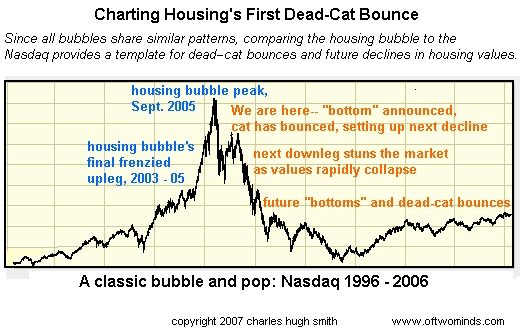
Here is a chart of the Nasdaq stock market bubble, 1996-2006, which shares the general shape of the 1996-2005 housing bubble: a slow ramp up for a number of years, followed by a final two-year blow-out of skyrocketing valuations. After the peak is reached, then the first decline is brief, and a "recovery" takes hold. But the recovery--in stock market parlance, a dead-cat bounce--soon gives way to the forces underlying the bubble's deflation, and a much sharper and longer declines takes valuations to levels which were dismissed as "impossible" in the heady days of rising valuations. There are two big differences, of course, between the stock market and the housing market: liquidity and margin. The housing bubble's peaks and bottoms are far more gradual, more "saucer-shaped," if you will, than the stock market, for the simple reason that the stock market is highly liquid and housing is not. You can sell $400,000 of stock in a few seconds, while unloading a $400,000 house can take months. The other difference is margin calls. When you borrow money against your stock portfolio, it's called margin. This is the stock market equivalent (roughly) of a mortgage--money borrowed against equity. In the stock market, however, when your equity falls below 50% of your account value, then you have to sell off stock until your equity returns to at least 50%. You are not allowed, in other words, to wait until you have negative equity. Alas, there are no margin calls on home equity loans, so wishful-thinking speculators can hold onto their "investment" houses until their equity has shrunk to a negative number--the value of the house is less than the mortgage. One of the proximate causes of the 1929 stock market crash was very low margin requirements. At that time, the minimum equity for margin was only 10%, meaning you could leverage your cash ten-fold--in essence, buying a $100,000 investment for $10,000. Sound familiar? It should. It's just like a no-down or low-down mortgage on a house. High leverage works like magic on the way up: a $10,000 down payment on a $100,000 house nets a ten-fold return if the house rises to $200,000. But on the way down, the effect is reversed: a mere 10% decline in a $200,000 house purchased with a $20,000 down payment wipes out all the equity. A relatively modest 15% puts the owner in a negative equity hole with no hope of escape--the value is less than what they owe. So we can expect a "saucer-shaped" series of downlegs and dead-cat bounces in the housing bubble's deflation. Though the housing market won't exhibit the sharp spikes of the highly liquid stock market, the general characteristics of any bubble's pop are easily identified, regardless of the market or time. The first dead cat in the housing bubble's decline has bounced as high as it can, and the second leg down has started. Note: I am short TOL (Toll Brothers), meaning if the stock continues its decline I make money. If it shoots up to its old highs I am an idiot, i.e. I will lose money. This is not a recommendation, it is a disclosure. There is a difference. NOTE: if you want to post a link to this entry, please go to this story link. January 1, 2007 A Doom and Gloomer Gives Up: Happy New Year! OK, I admit defeat: there will not be a recession in 2007, or ever again. The U.S, and global economy will continue on an upward trajectory of strong growth for the foreseeable future, powered by the same formula which has worked its magic for the past six years: unlimited money for borrowing, low interest rates and easy lending standards. We all know how this has worked: as trillions of dollars of freshly created debt floods into the global economy, assets--real estate, metals, stock, bonds, collectibles, companies, you name it--rise in value, pushing equity higher, which then enables the owners to borrow even more. Doom-and-gloomers (yes, like me since 2003) keep insisting the imbalances created by this global debt bubble will bring the system down, but ha! There's no limit to the debt the average American can support. As this chart shows, if debt continues at its current pace, it will reach 100% of disposable income in a few years. 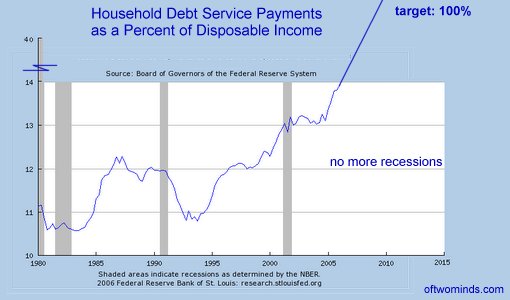
To which we boosters and cheerleaders say: so what? American consumers will just borrow more to make their debt payments; what's the big deal? (I found this chart over at Fred Roper's Satellite Sky blog, and made a modest extrapolation. I recommend his commentaries on national healthcare and other topics.) OK, so actually I'm still a doom-and-gloomer. Over the past year, I have posted chart after chart reflecting the uptrend in U.S. bond yields, which presage a trend of rising interest rates. As interest rates rise, so do payments--for consumers, corporations and the government itself. As interest payments rise, the ability of new borrowers to keep jacking up asset prices falters, and asset prices actually begin falling. (Look no further than the housing market for evidence of this.) As assets fall in value, owners find they can no longer borrow more money; in fact, as this chart shows, their disposable income shrinks rapidly as servicing their existing debt takes an ever-increasing chunk of their income. Less money available to spend means less money flowing into the economy. This contraction of spending leads to a contraction in the economy, which is called--oh, dread!--a recession. Back in the distant, misty past of pre-bubble economies, this cycle of growth of debt and contraction/paying down of debt was called "the business cycle." But the powers that be found the down years of such cycles politically inconvenient, so they decided to rid the world of the business cycle by never encouraging debt to shrink. So here we are, running on a treadmill of ever-increasing debt--and the treadmill, despite all the frantic manipulations of the powers which have benefitted so greatly from the debt expansion, is speeding up. As it speeds up, consumers find a walking pace is no longer sufficient; now they have to start running. And as they tire, they start falling off the treadmill into bankruptcy and foreclosure. Sure, the wealthy will be gliding along, barely noticing the thinning crowd; perhaps they'll even be pleased to find less people on the beaches of Maui and Ibiza. I now introduce "the Greenspan Clock." For those of you with short memories, Fed Chairman Greenspan voiced a famous concern in early December, 1996, that the stock market--at that point, barely starting its final stratospheric bubblicious ascent--was in the grip of an "irrational exuberance." It took 3 years and 4 months for that irrational exuberance to play itself out. Many of us began voicing doubts about the sustainability of the housing/asset bubble in mid-2003. We have been mocked and scorned as doom-and-gloomers, pocket-pundits who cling to outmoded views of finance and economics, views which have been banished to history's dustbin by the eradication of risk and high interest. The hour hand of the Greenspan Clock has clicked into 2007, three years since the unsustainable nature of the U.S. and global economy became too obvious to ignore. Is the 3.5 years timetable of "irrational exuberance" about to play itself out once again? Stay tuned. Note to readers: Since launching this modest blog in May 2005, site traffic has increased from 28,823 visits in 2005 to 453,793 in 2006. Bandwidth (data served to visitors) jumped from 2.5 GB in 2005 to 97 GB in 2006. Thank you once again for your readership, and I hope you'll stick around for the 2007 oftwominds.com show. To view previous entries in December, go to weblog December 2006. Please browse this month's entries and the archived wEssays listed in the sidebar. If nothing here strikes your fancy, skim through my recently published articles (generally in the San Francisco Chronicle) and my archives back to 1995. I would be honored if you link any essay to your website, print a copy for your own use or add my RSS or Atom feed. And of course I appreciate your recommendations of this weblog and your comments: csmith@oftwominds.com. wEssay noun, combination of 'web' and 'essay,' denoting a short online essay which exploits the hyperlinks, interfaces and interactive capabilities of the World Wide Web; coined by Charles Hugh Smith on May 1, 2005, in Berkeley California. Aphorisms I live by: "May a fair road always be open to you." (CHS, April 2, 2006) The way of the Tao is reversal." (Lao Tzu) "Chance favours the prepared mind.” (Louis Pasteur) All content and images copyright © 2006 - 2007 Charles Hugh Smith, All rights reserved in all media, unless otherwise credited or noted. |
 |
Subscribe via RSS: search my site:
Worth Visiting:
ilind.net Mish's Global Economic Trend Analysis Marin Real Estate Bubble View from Silicon Valley Chris Johnston-futures trader Rick's Picks Gold Eagle Econotech PennyJar Satellite Sky Timothy Brackett's Investment Strategy RV Now-Jim Twamley John Francis Kinsella author/painter Letter from Basque Country buy my novel I-State Lines at The Kaleidoscope (indie bookstore, free shipping) Or from amazon.com: I-State Lines If you want to own gold, I recommend: Buy gold online - quickly, safely and at low prices at BullionVault If you need a quick gift, I recommend: Amazon.com gift certificates Note: at no cost to you, I earn a small commission on purchases made via these two links. |
|
Our retail policy: Nothing is for sale except books/films I recommend and my own novel I-State Lines (via links to Amazon.com and The Kaleidoscope: Our Focus Is You independent bookstore) Free alternative: find them at your local library. Though I earn a small commission on Amazon.com books and gift certificates and gold (BullionVault) purchased via links on my site, I receive no advertising fees for any links, ads or materials on my site. |
home |